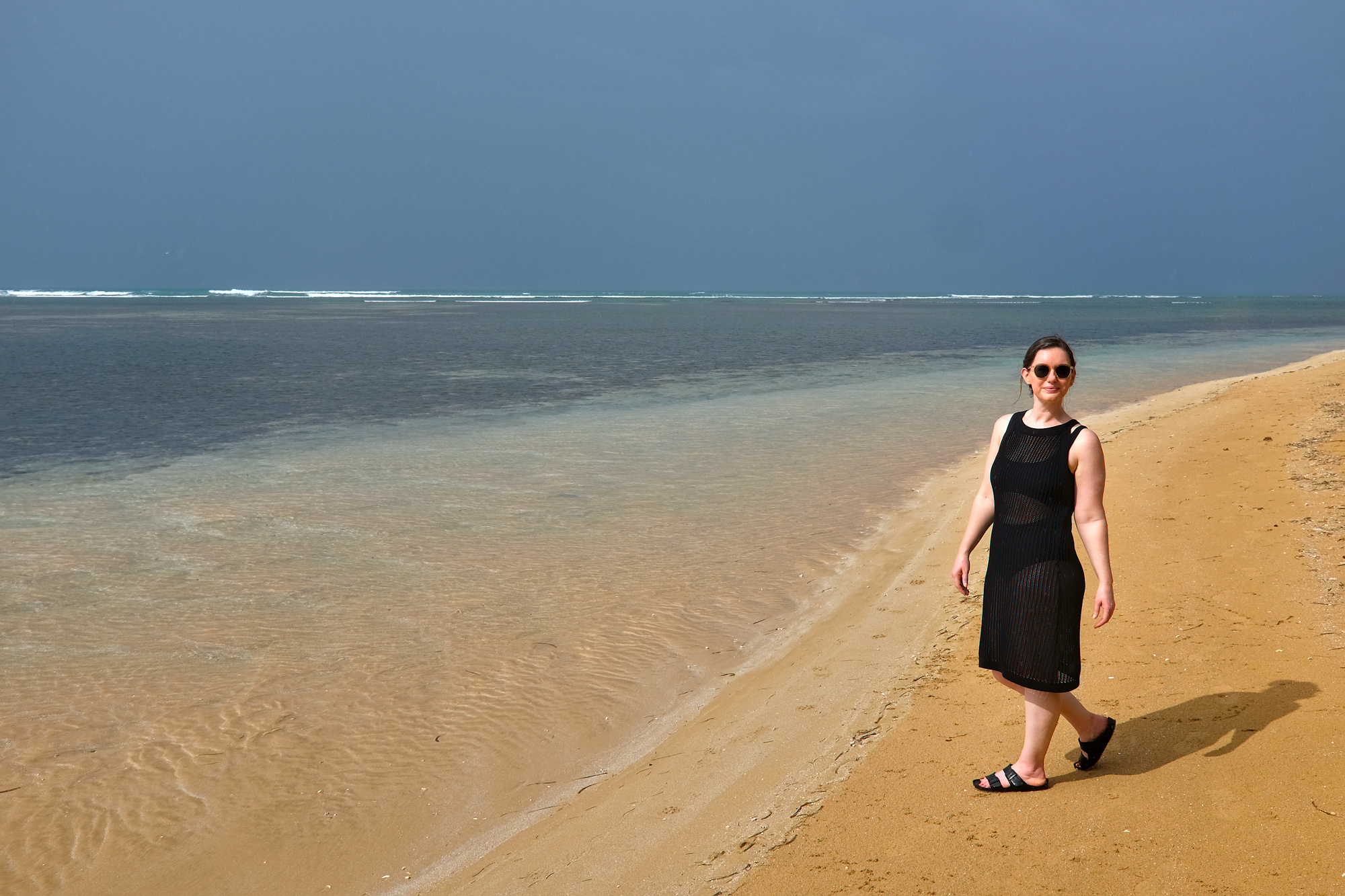
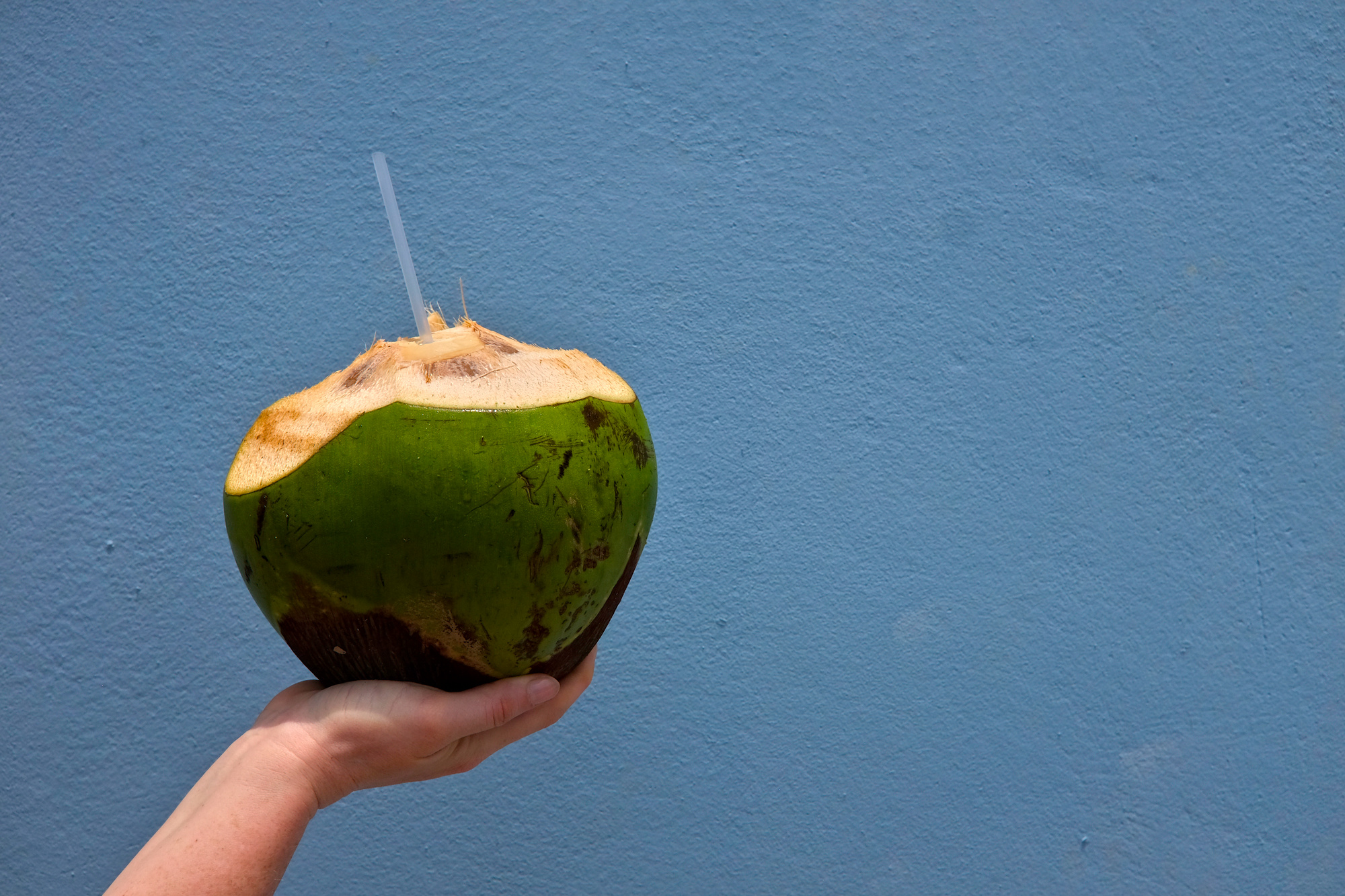
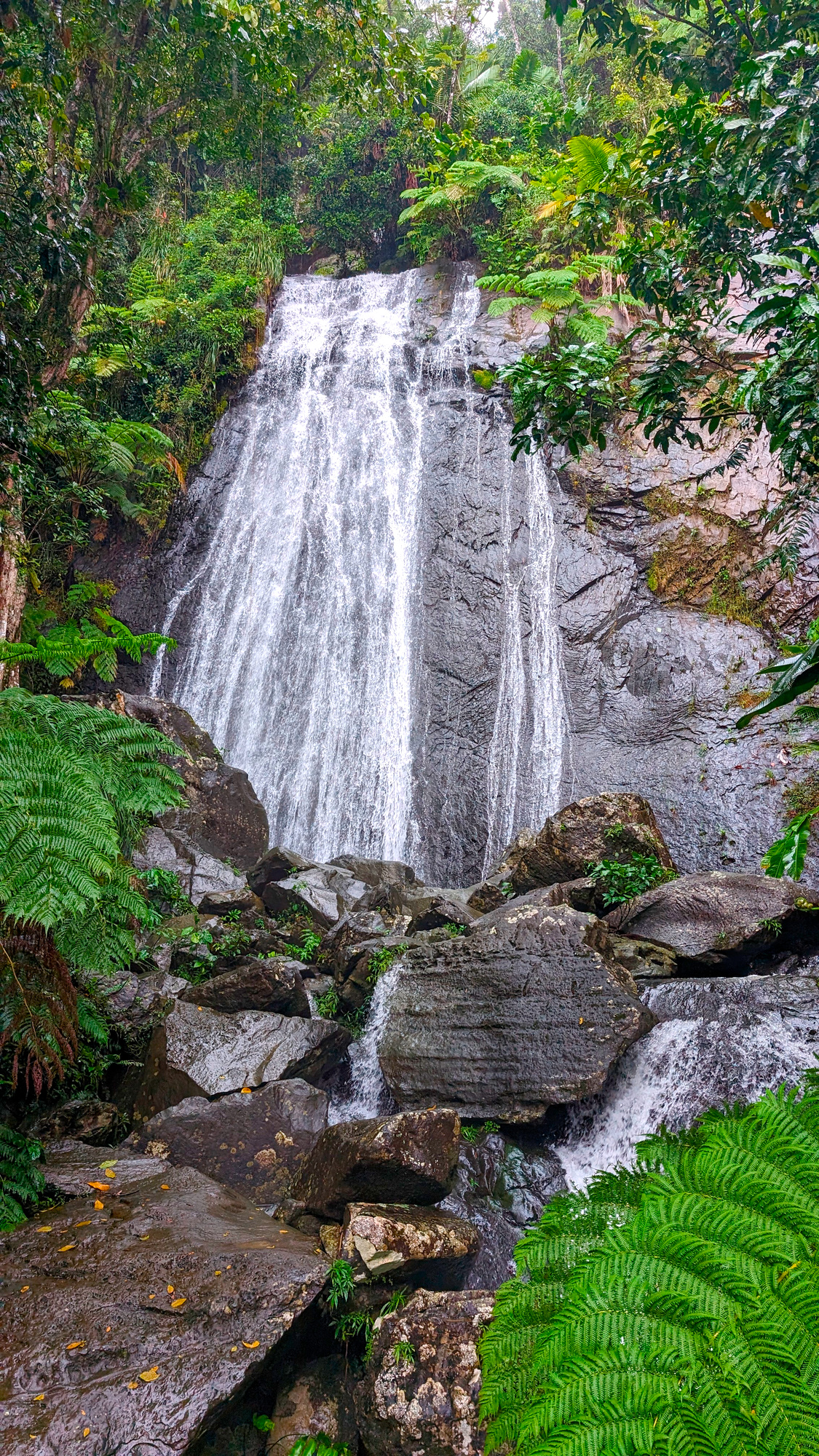
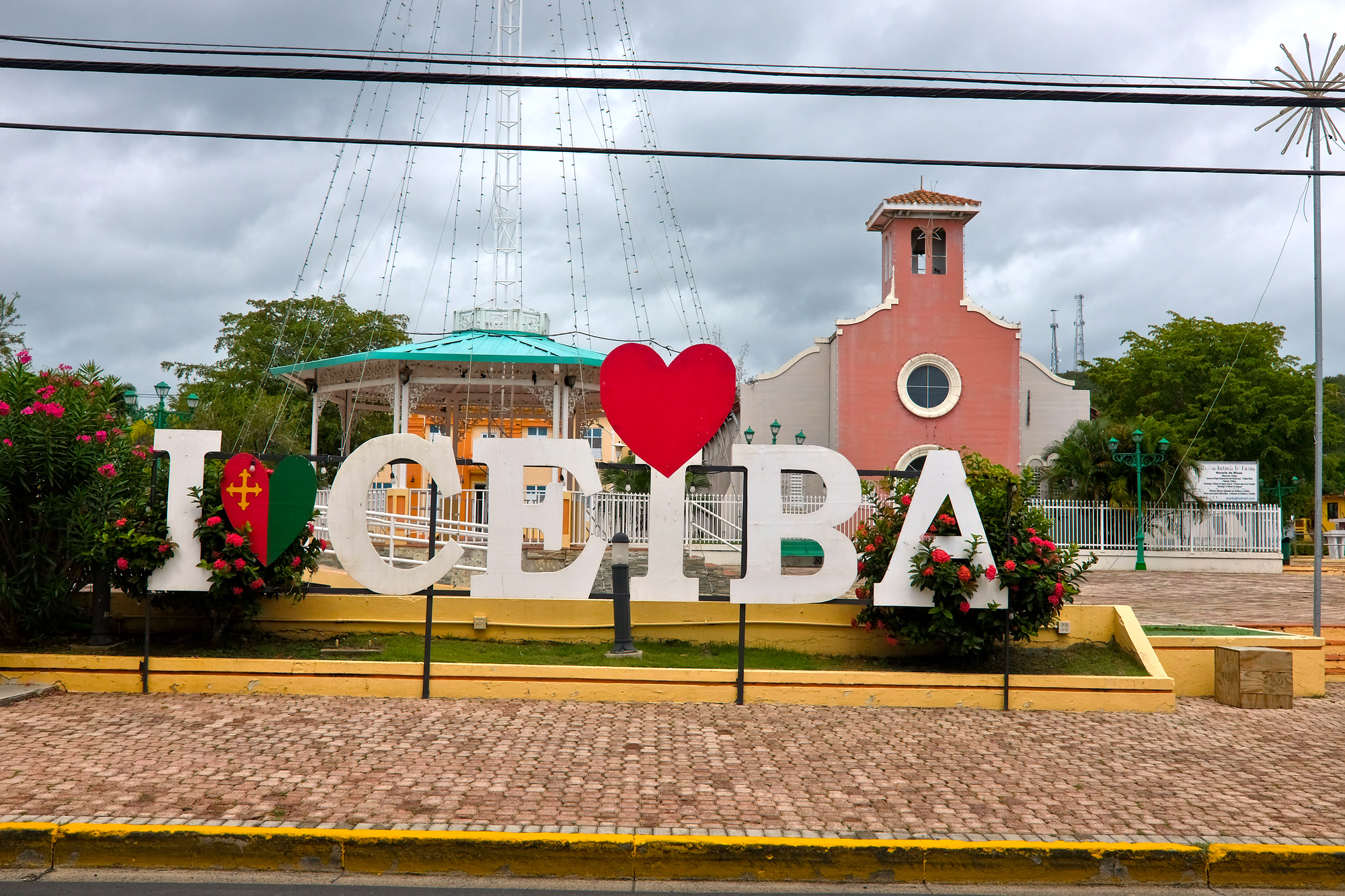
Sharing the best of Puerto Rico's east coast, from the lush rainforest to sandy beaches.
With San Juan in my rearview mirror, I could feel my pulse start to slow.
Don’t get me wrong – I fell deeply, quickly in love with the vibrant capital city, but San Juan’s busy pace echoed too many of my other recent travels and I was desperately in need of some quality time reconnecting with nature.
As a travel blogger, there’s immense pressure to cover all the things in my weekend travel guides, and it often leaves me with little downtime. I’m not one to complain – I wouldn’t have it any other way.
Except when I’m exploring paradise.
Looking for more on Puerto Rico? Find all my guides in one place!
When visiting the island, it felt imperative to carve out time to enjoy some of Puerto Rico’s natural wonders: its rainforest and its beaches. To make the most of every moment, Michael and I decided to call the East Coast our home base for two nights.
Tempting as it was to head west or circle the island, I couldn’t stomach the thought of spending so much of our time in the car. Why would we choose to do that when we could be soaking up the scenery without a pane of glass separating us from it?
This post is not sponsored but contains commissionable links
We spent far longer planning this portion of the trip than its San Juan counterpart, scouring maps and photos to pinpoint the best place to stay and building a relaxed itinerary for El Yunque and nearby beautiful beaches. The result was a journey that I can only describe as perfection, and I’m so thrilled to bring the same experience to you today.
Read on to discover my favorite spots on Puerto Rico’s East Coast:
WHAT TO SEE & DO ON PUERTO RICO’S EAST COAST
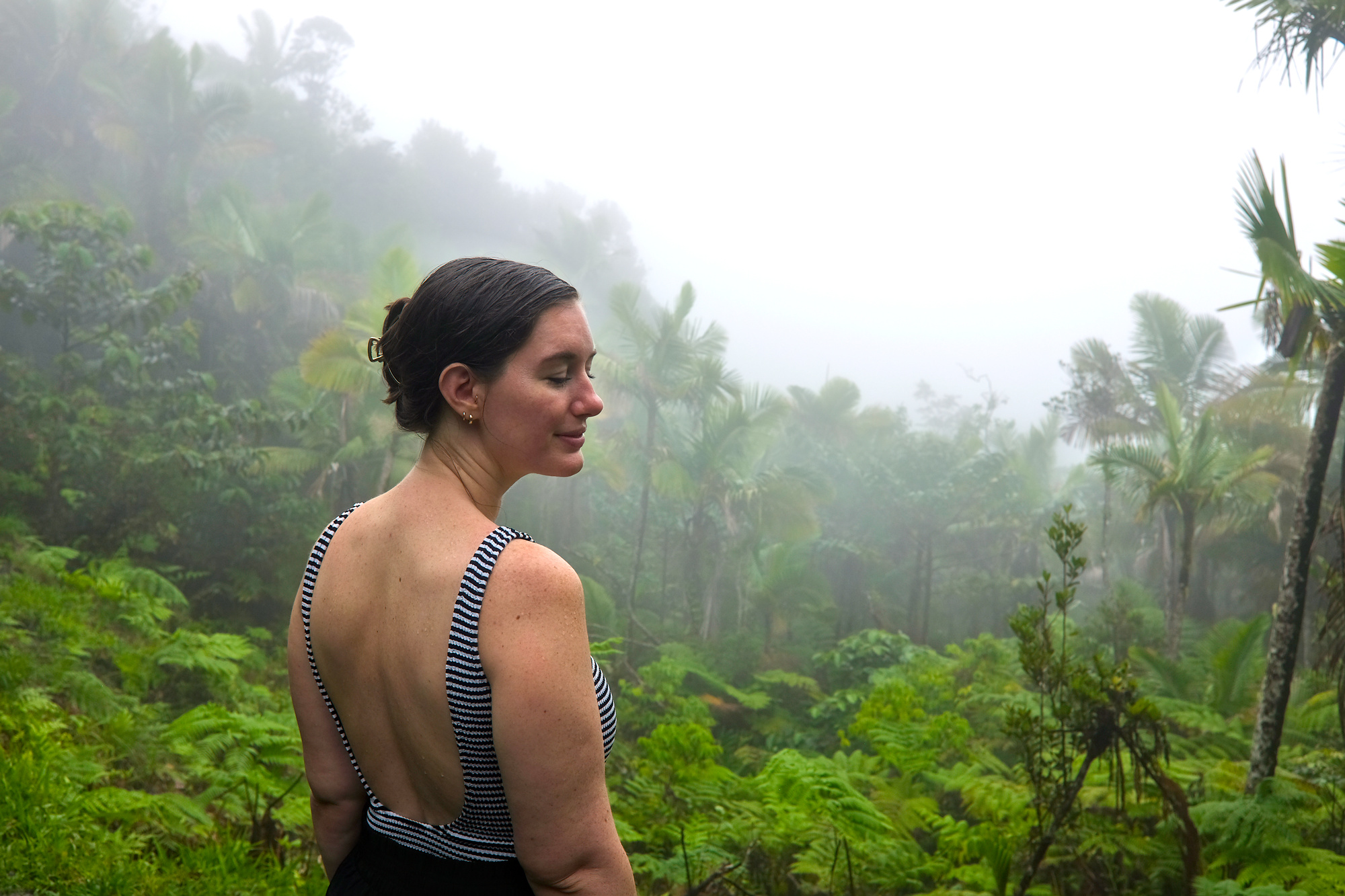
El Yunque National Forest
As the only tropical rainforest in the United States, El Yunque National Forest is a true natural wonder with more than 200 species of trees and plants (many of which you won’t find elsewhere in the country!). The park’s towering mountain peaks, cascading waterfalls, and winding rivers create a breathtaking landscape that calls visitors to leave the big city behind. But how do you get there?
The entrance to La Mina Recreation Area, the portion of the park most visitors choose to see, is located about an hour by car outside of San Juan, with both highway and rural portions of the route. As of August 2023, the park is no longer using a timed ticket entry system, however, park rangers are monitoring traffic and the gate will close when it reaches the capacity of 200 vehicles.
To ensure you have the chance to visit, beat the crowds by arriving early and/or visiting on a weekday. Admission to the park is free, though there is an additional charge to visit El Portal, the visitor’s center (Michael and I opted to head straight into the park – if you visit El Portal, be sure to leave a comment and let us know if it’s worth a stop!).
Once inside the park, a single roadway snakes through the mountains, offering the chance to pull off at designated areas to hike and sightsee (and helpfully, this out-and-back drive makes it impossible to get lost in your vehicle). Cell service is spotty in the park, and I recommend downloading the official app before you leave home. It’s finicky at times, but it houses the latest map and can pinpoint your location even if you don’t have cell or data service.
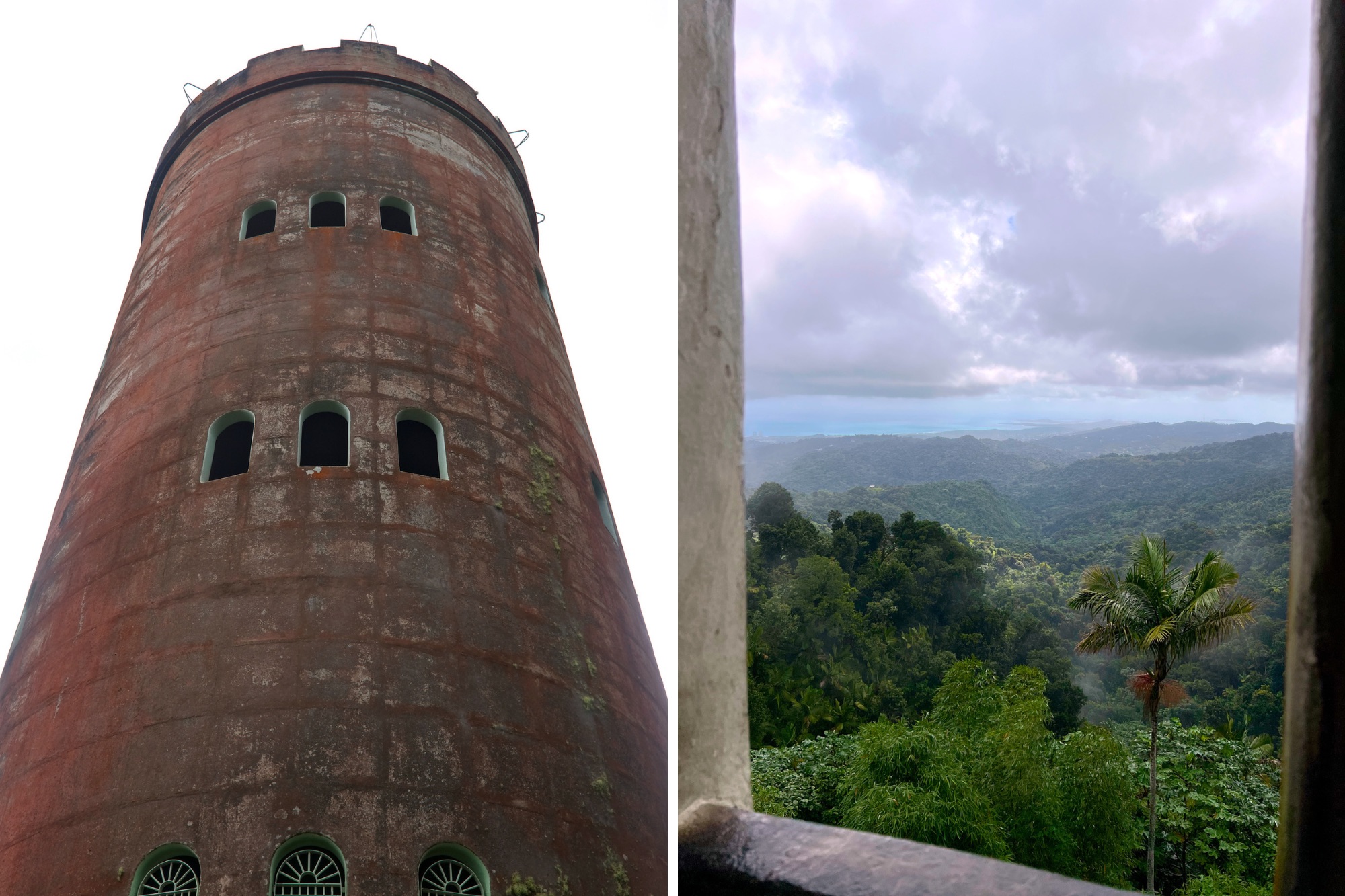
We began our visit with a stop at Torre Yokahú, an observation tower built in the 1960s. Ascend the tower’s 98 steps for breathtaking views of the canopy from above, including four different types of forest. On a clear day, you can see all the way to the U.S. Virgin Islands, but we weren’t so lucky.
We did spot portable restroom facilities down below, however, and I suppose that’s not a bad consolation prize. Restrooms can be found near most of the parking areas; I noted them at Torre Yokahú, Palma de Sierra, and Palo Colorado.
There’s a version of myself that likes to think she can tackle multi-hour hikes in the rainforest, but in practice, I am not at that point in my journey (yet? Yet!). To sample El Yunque’s hiking experience, Michael and I walked a stretch of the Caimitillo trail. Though it is ranked as an easy trail, we were forced to tread slowly and carefully along the slick, muddy path – that is, as long as we stayed on the trail. After forty minutes of hiking, we realized we’d missed a turn on the 0.4-mile trail and instead were on the longer, more challenging El Yunque Trail. Whoops.
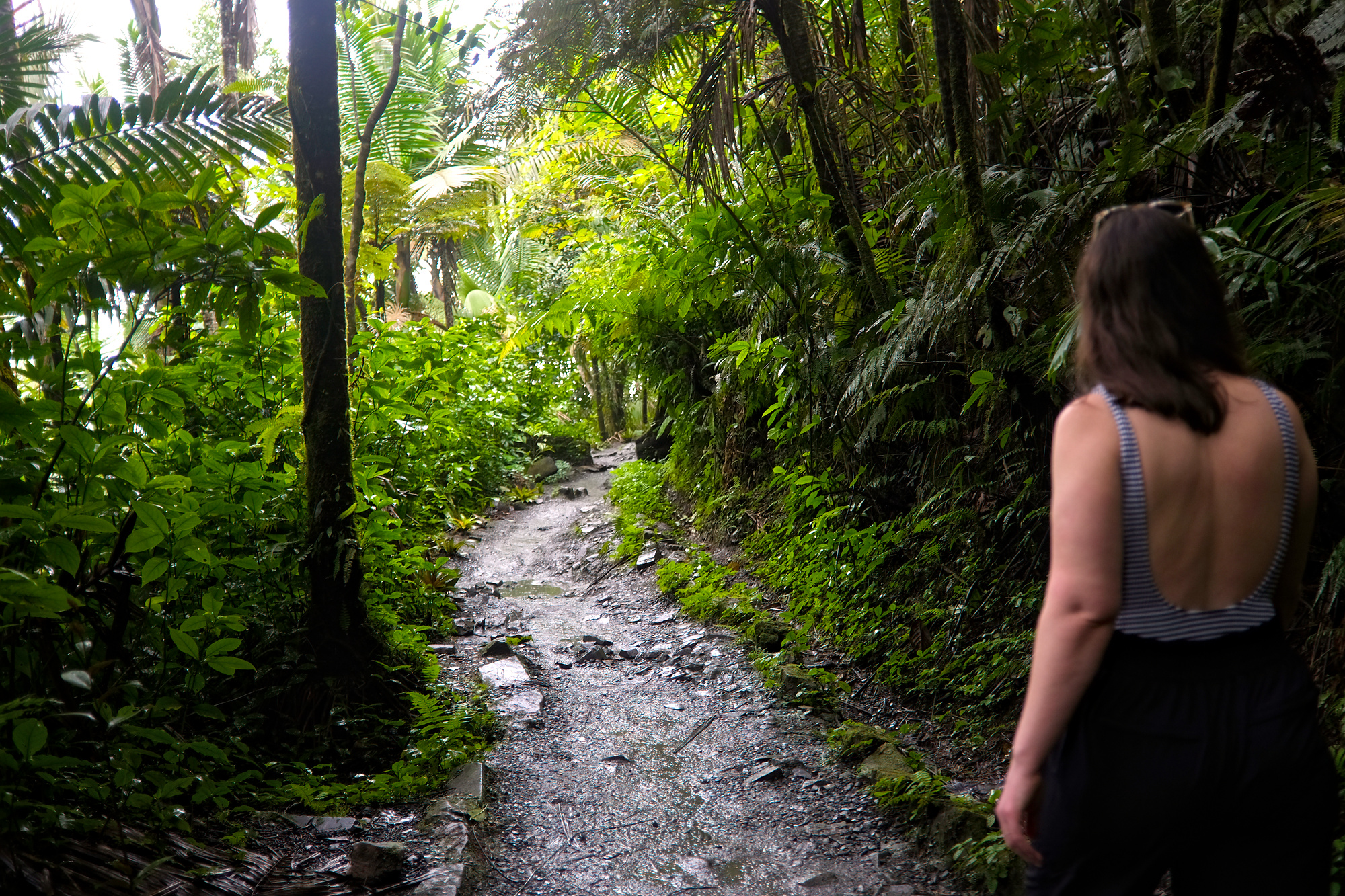
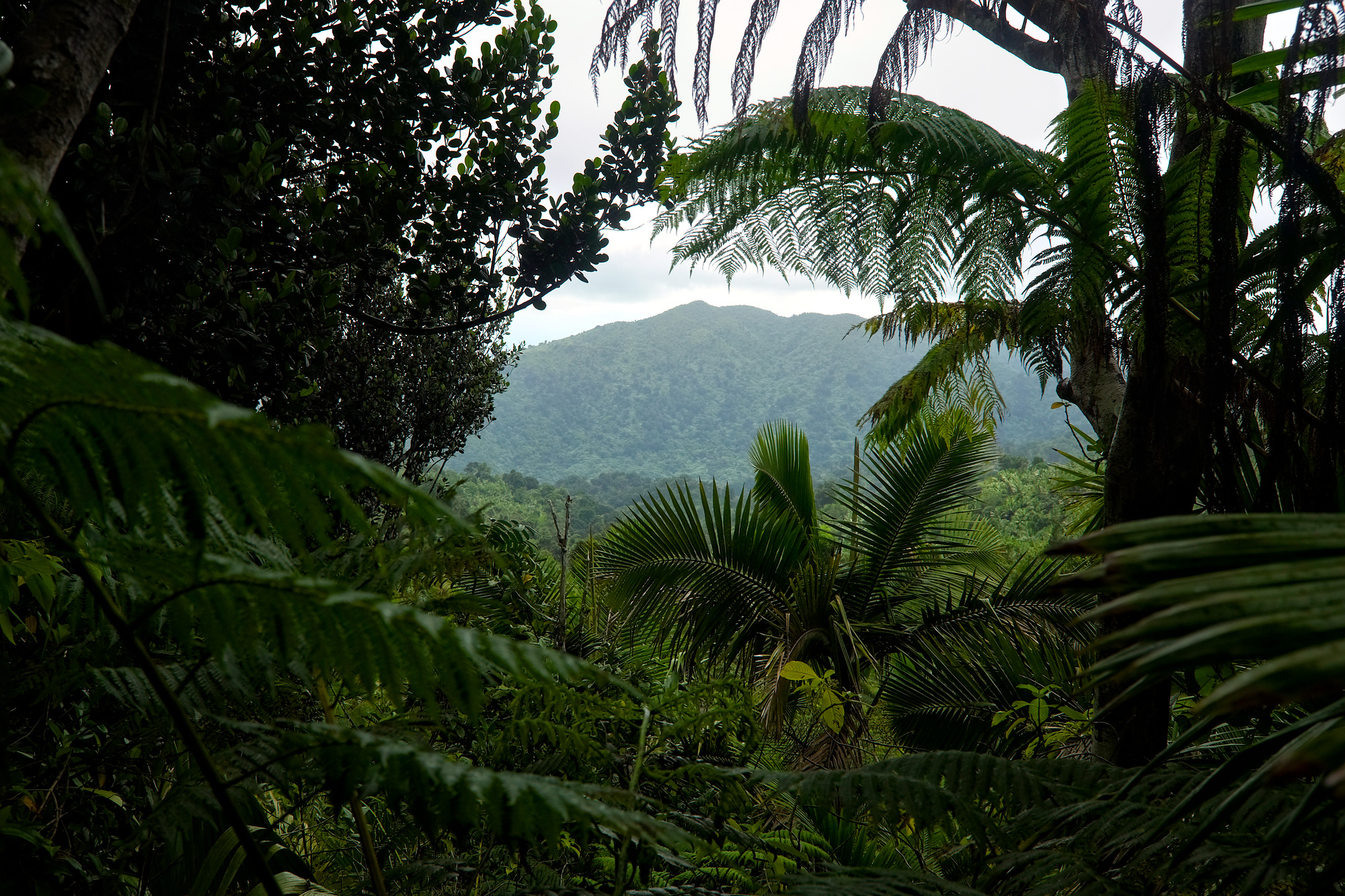
I can’t say I really regret it, though. The rainforest is a full sensory experience, from drops of rain hitting the outspread tree leaves to the song of Puerto Rico’s famous coquí frogs, and every step led to yet another symphony.
By the time we made it back to the car, I can say we were definitely ready for lunch. I’d read that there are no food vendors in the park, but I’m happy to share that information is outdated. You can now find a small concessionaire at Palma de Sierra with locally-inspired food and drink. The prices are typical of any attraction restaurant, so we weren’t too disappointed by eating the takeout meal we brought in from San Juan.
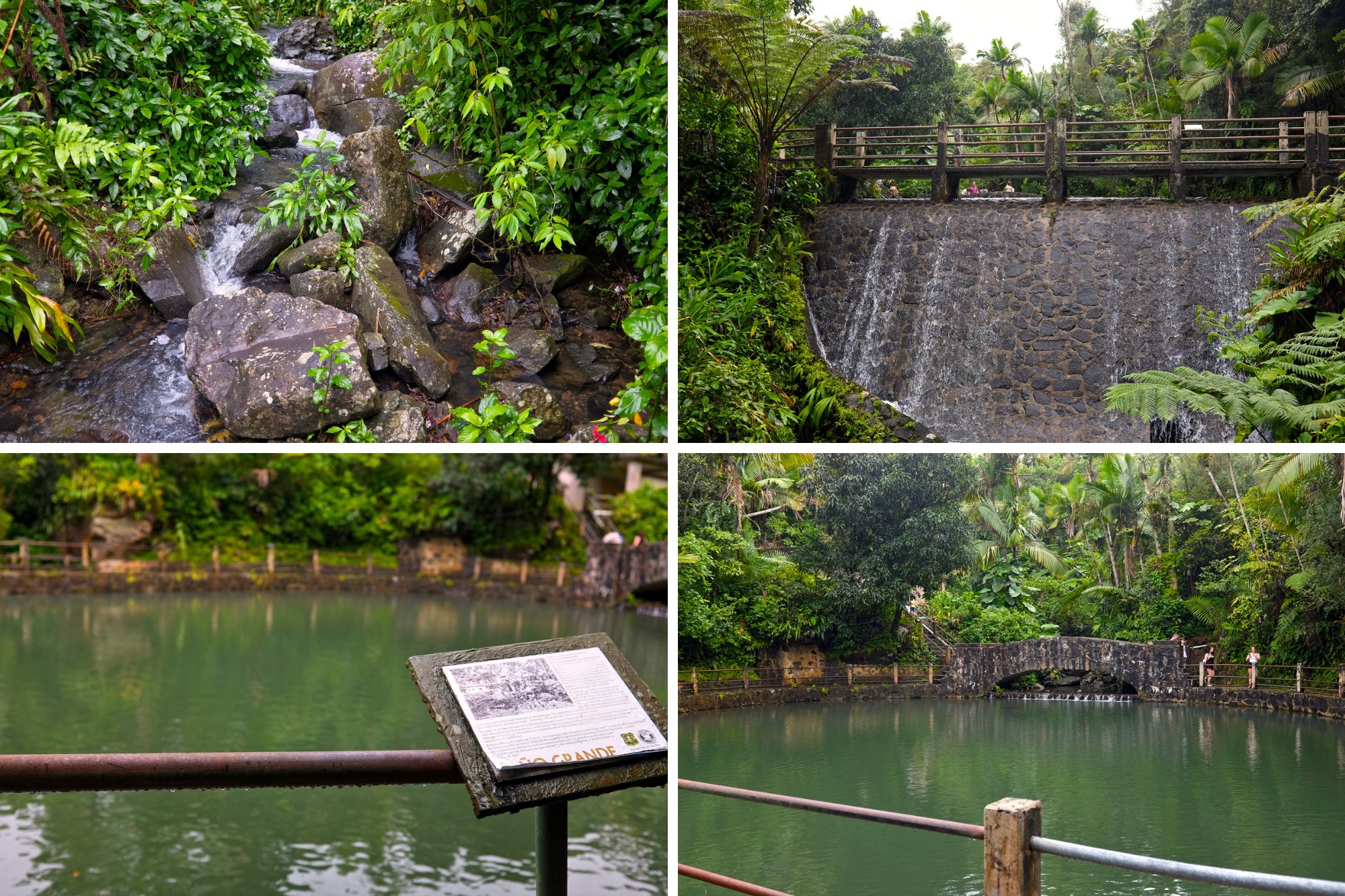
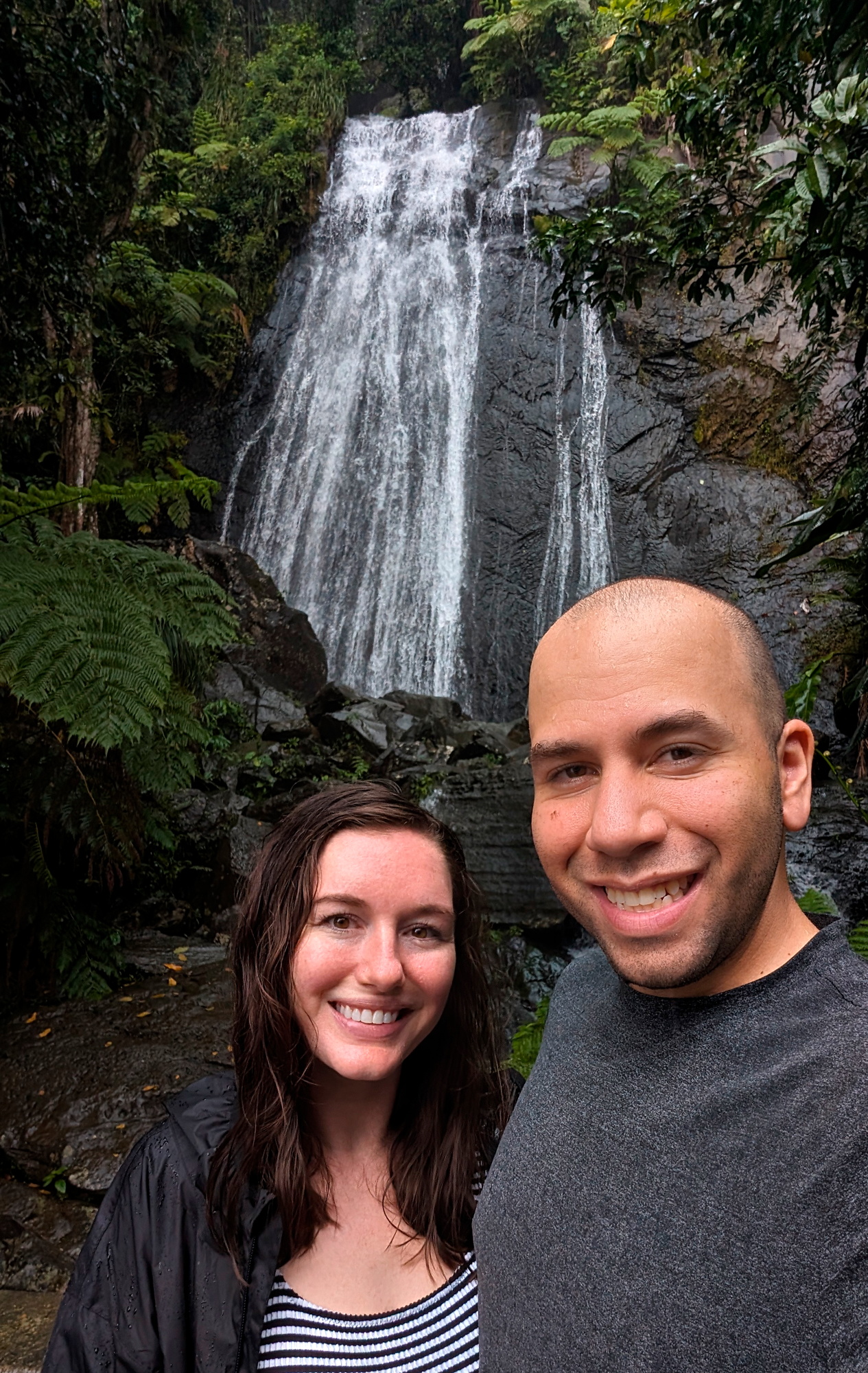
After lunch, we were keen on an easy walking path. The manmade Baño de Oro is no longer safe to use as a swimming area, but it makes for a classic El Yunque photo op.
We purposely saved our waterfall chasing until the end of our time in El Yunque, so we would be dry and comfortable for most of the day (the joke’s on us because it rained all day. Rain! In the rainforest! Who knew?!). La Coca Falls is located near the entrance of the park, and while you can’t hike to it or swim in it, it’s a beautiful – and accessible – waterfall.
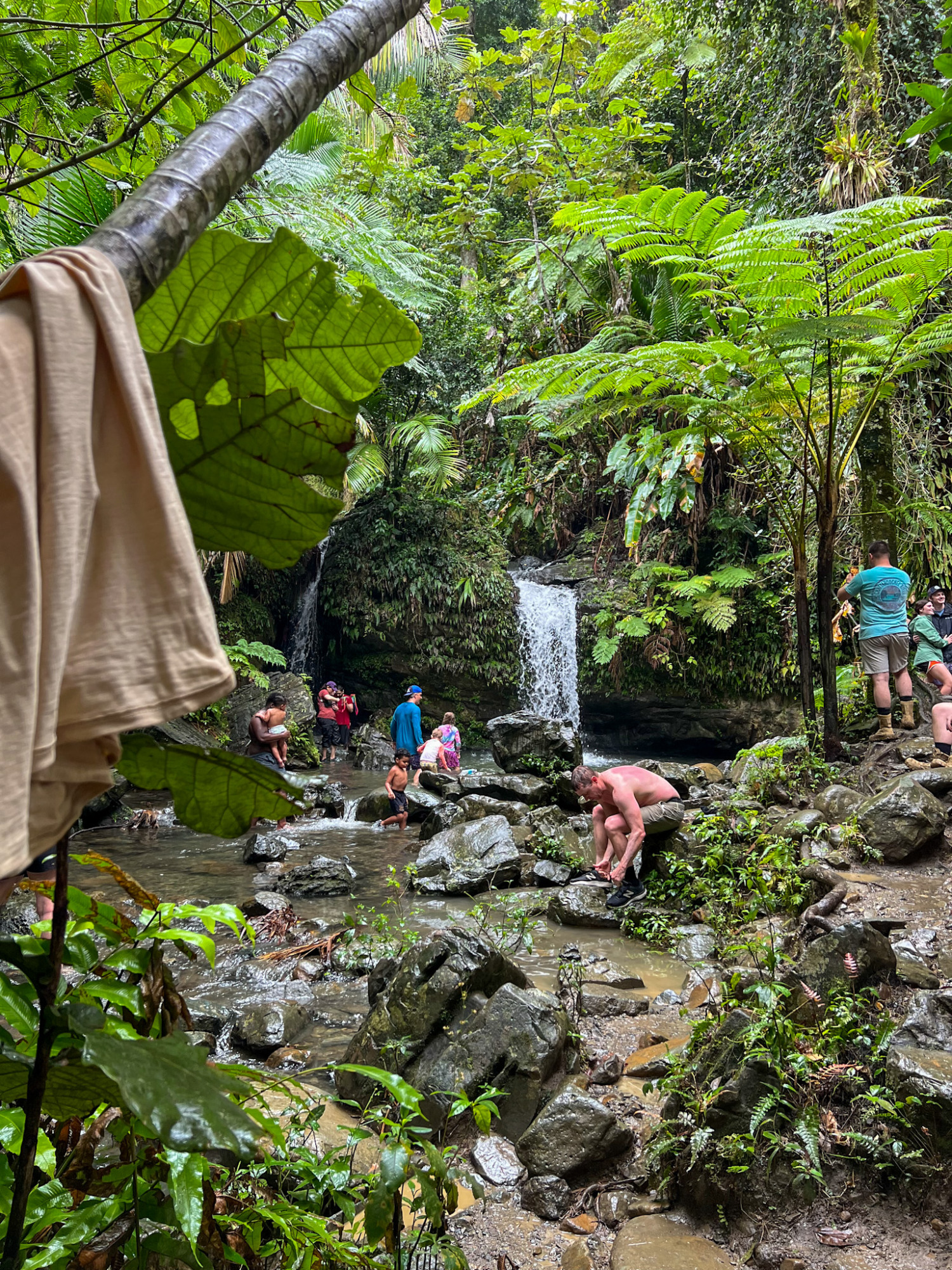
It was the perfect preview before our final stop of the day: Juan Diego Falls. With the closure of La Mina Falls, this is currently the only waterfall with a pool you can wade into within the park – and as you can expect, it’s quite a popular spot. Juan Diego Falls is a short trek from the parking area (with a parking time limit of thirty minutes), and soon you can be cooling off under a natural waterfall… along with everyone else.
But – and this is a “but” only for the very adventurous and physically capable – there’s a second portion of Juan Diego Falls that is much more likely to be secluded. The upper falls are located at the top of a steep, slippery second trail off to the right of the lower falls. Climb at your own risk, and prepare to get muddy in the process. By the time Michael and I made it to the top, others who were attempting the trail at the same time had decided to go back (including a group of young and agile-looking teenagers).
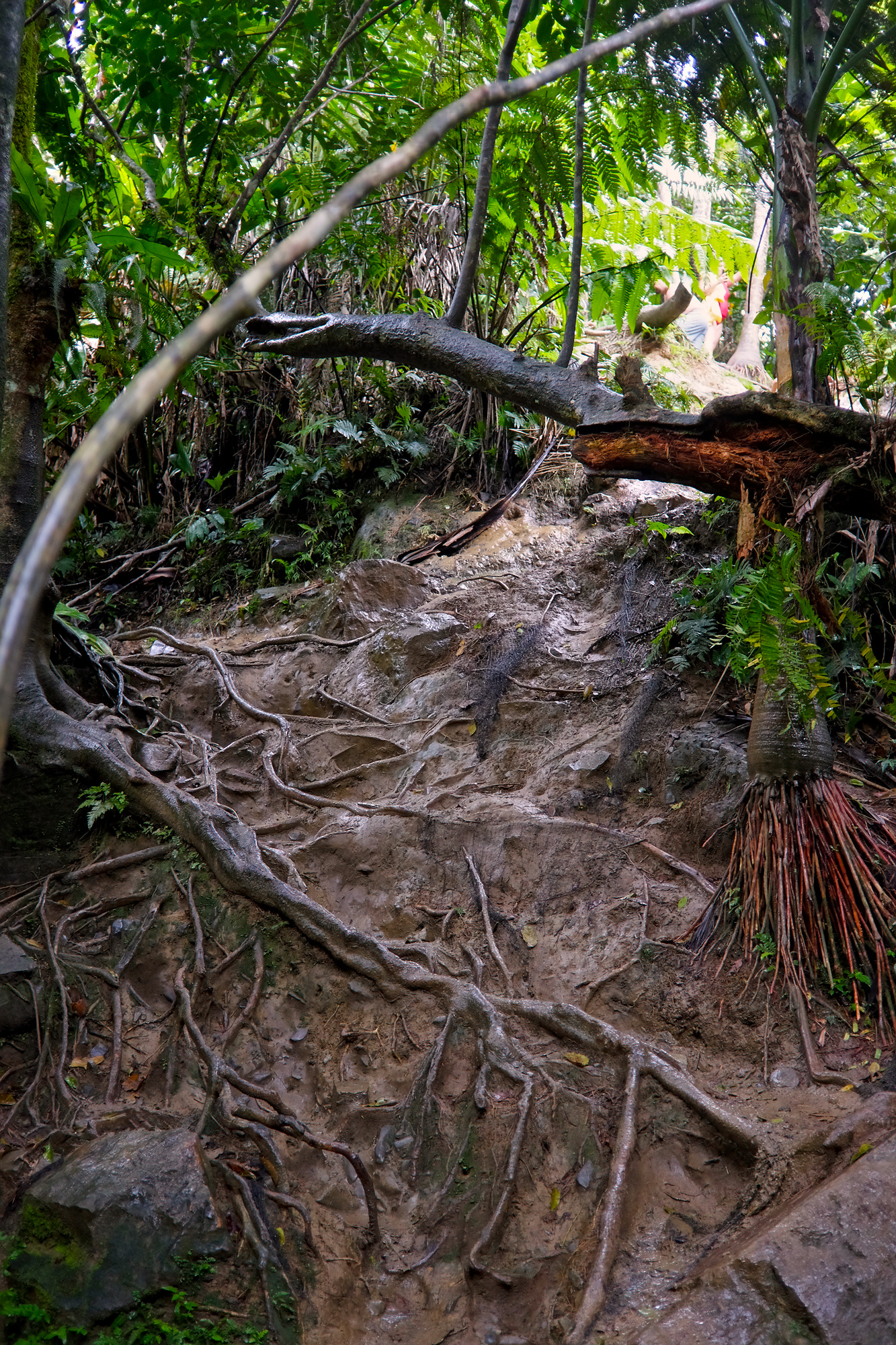
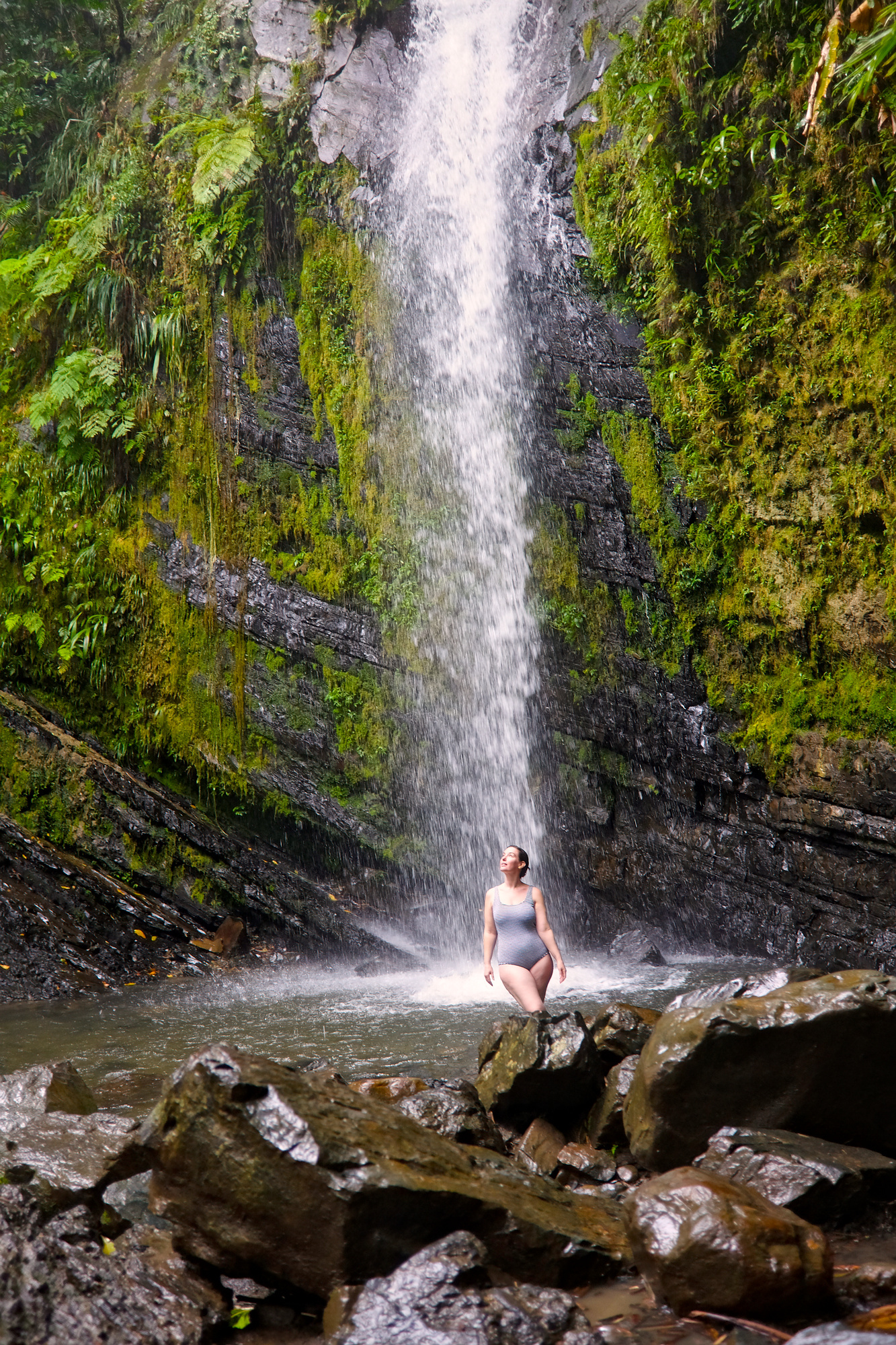
The reward far exceeded the strenuous effort, as we found ourselves alone in front of a mighty cascade of water in the middle of the forest. Not wanting to risk slipping and falling on the mossy rocks, we only waded knee-deep into the refreshing water, but this is a travel memory I will certainly treasure forever.
Following an experience that couldn’t easily be topped, it was time to call it a day. I suspect this living, breathing forest leaves an impression on every visitor who takes the chance to visit, but now is a good time to remind you that visitors should do their best to avoid leaving an impression on the forest. Follow the guidelines, park only in designated areas, keep to the trails, and bring all trash with you to discard after leaving, so everyone can continue to enjoy the same experience.
→El Yunque National Forest // PR-191, Río Grande, 00745, Puerto Rico
—
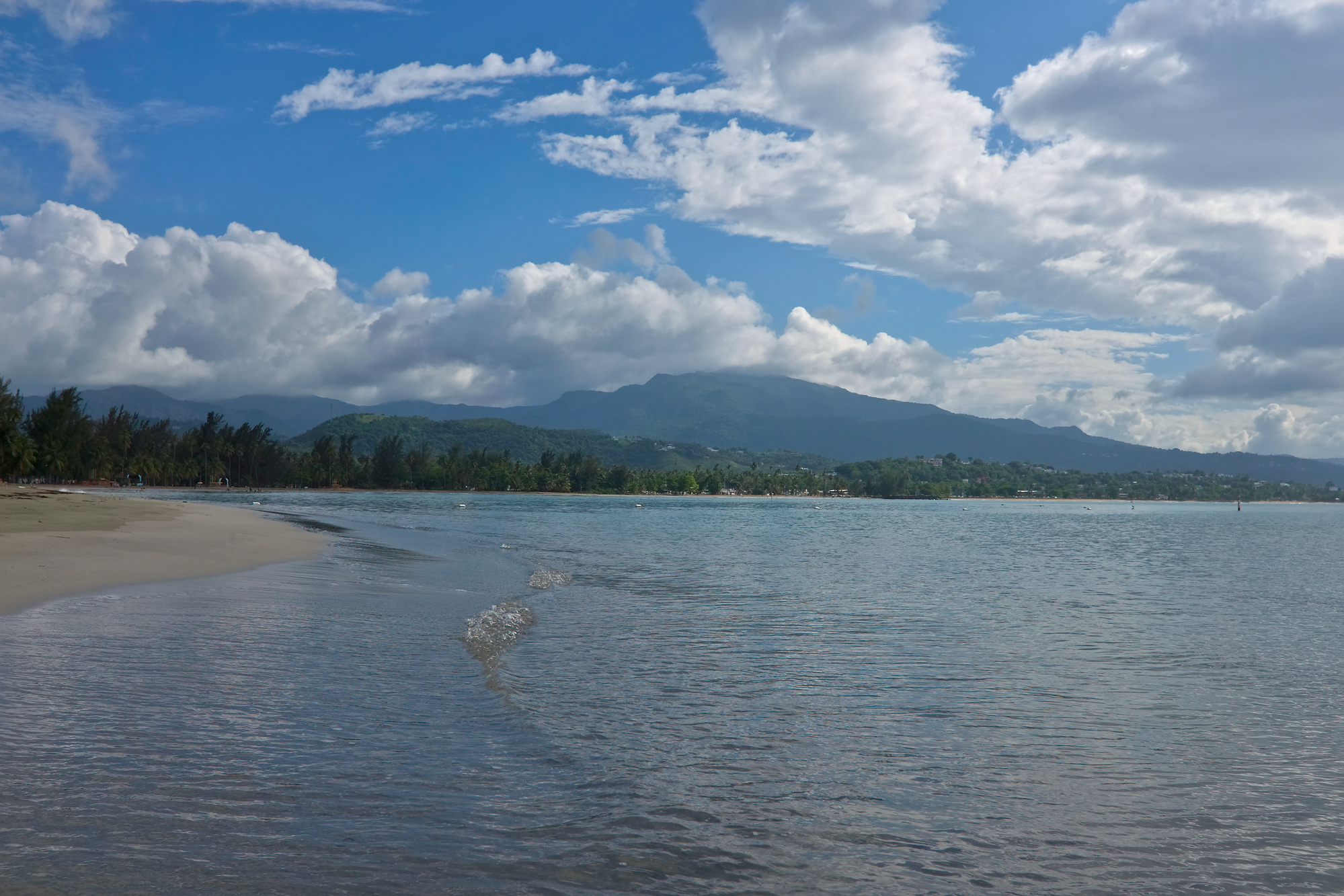
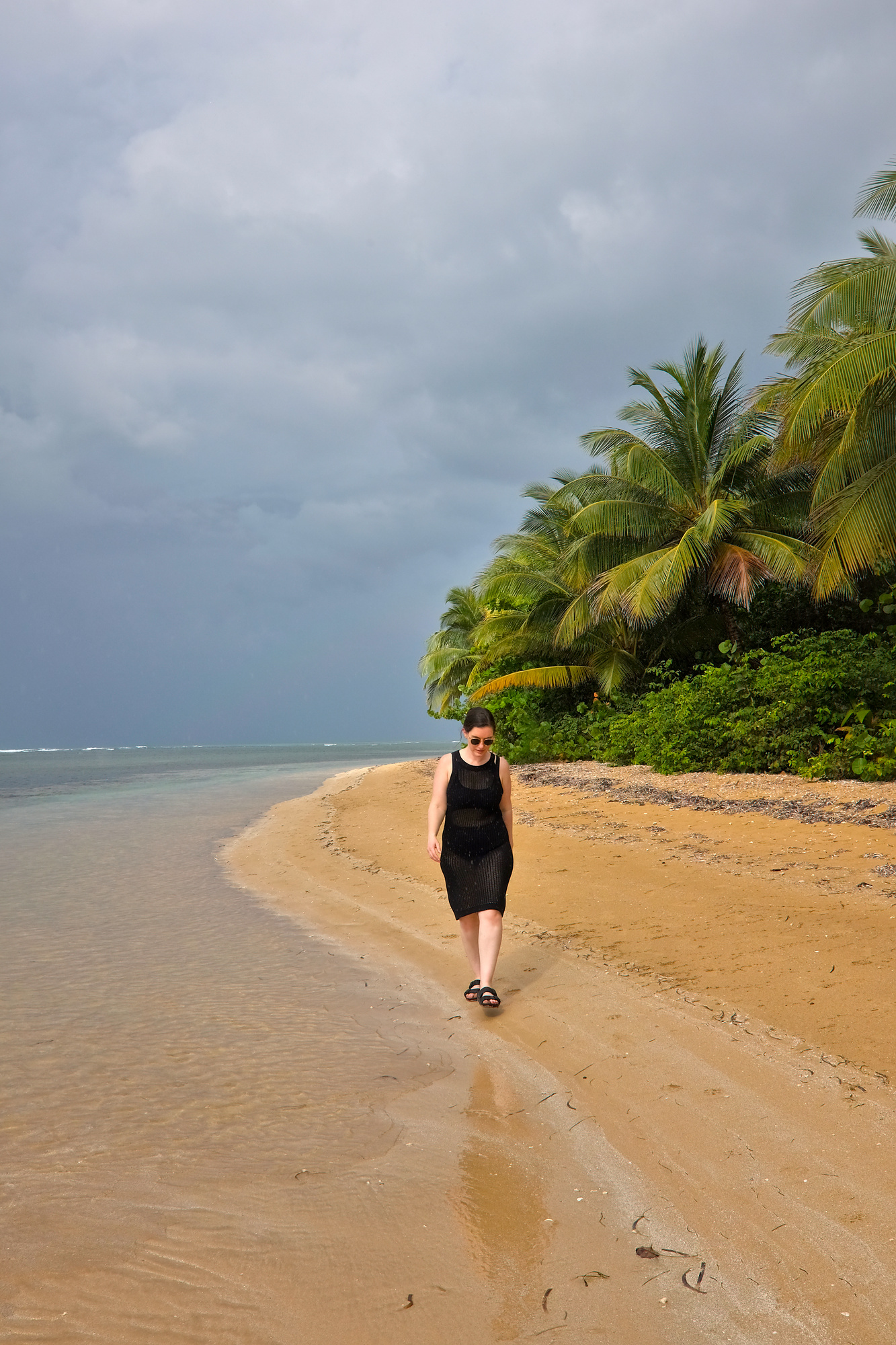
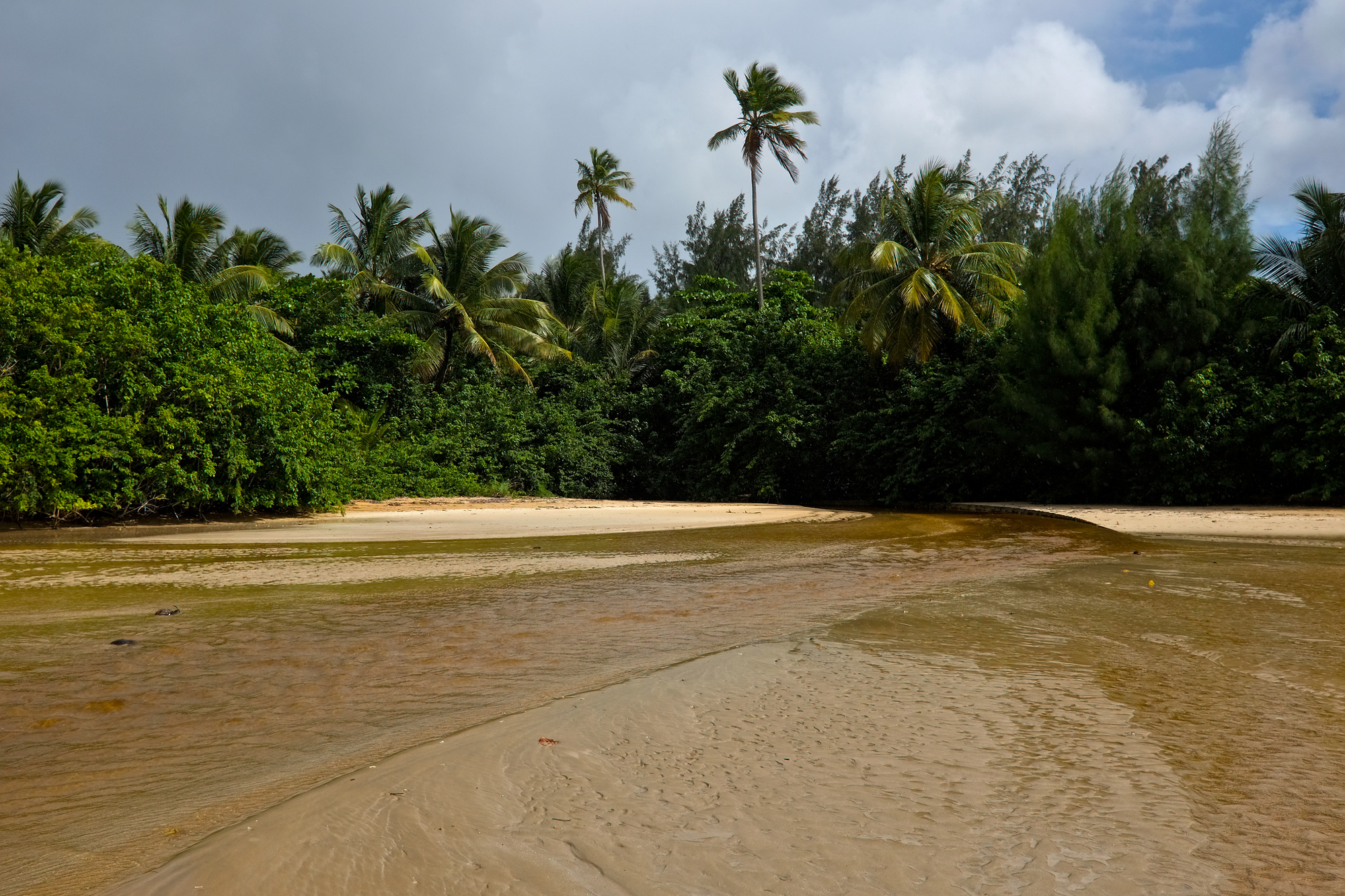
Playa De Luquillo
If you visit Puerto Rico without going to the beach, did you really visit?
With 300 miles of coastline, visitors are spoiled for choice on where to dig their toes in the sand. But with only a limited amount of time to visit Puerto Rico’s beaches, Playa De Luquillo offers travelers a gorgeous beach experience with all the necessary amenities.
While it’s true that all beaches in Puerto Rico are public (even the ones bordering fancy schmancy resorts), it’s not necessarily true that you can reach them all by vehicle or swim safely along the shore. This beach in Luquillo features a paid parking lot, calm waters, and restrooms – and proximity to the famous Kioskos de Luquillo, where you can eat and drink to your heart’s content (but more on that later in this post!).
A short walk north, past where a cool creek flows into the ocean, places you on a small, pristine bit of coastline that feels miles away from the rest of the world. Isla del encanto, indeed – however, it bears stating that you should only swim in designated areas when flags or lifeguards indicate it is safe to do so. Drownings are not uncommon, even among strong swimmers.
→Playa De Luquillo // Luquillo 00773, Puerto Rico
—
Bioluminescent Bay Tour
The phases of the moon aren’t often a top travel consideration, but for one of Puerto Rico’s most spectacular natural attractions, you’ll need to take the lunar cycle into account.
Depending on who you ask, there are only five bioluminescent bays in the world – and Puerto Rico is home to three of them. Laguna Grande in Fajardo is the easiest to access in the region, and it’s also the most visited due to its proximity to San Juan (the other bays are found in the town of Lajas and on the island of Vieques).
The only catch to seeing the glow from the Pyrodinium bahamense organisms beneath the water’s surface? It needs to be dark, quite dark. The best time to paddle Laguna Grande to experience this phenomenon is at or around the new moon, though many tours provide coverage to block out the moon and other lights nearby.
There are a number of tour groups offering kayak tours to Laguna Grande, and after consulting the reviews, we landed on Yokahú Kayak Trips. The 6:30 p.m. start time was ideal, as it allowed us to arrive and begin our paddle before dusk. After checking in and going through a very short demonstration, we headed down to the waterfront.
Each kayak on this tour is a two-seater, and the guides instructed us to sit with the lighter person in the front. Single file, we paddled from the shore through a narrow channel surrounded by mangrove trees, watching out for the glow lights on our neighbor’s kayaks to keep pace and avoid getting caught in the roots and branches.
After about twenty-five minutes, the channel suddenly opened into a wide lake and our guides had us paddle to a point to tether and anchor our kayaks while we waited for darkness to fall. While we waited, our primary guide Jesus shared about the impacts of light pollution on the area and the challenges that locals face in trying to protect the lagoon. Eventually, the removal of the glow lights mounted on each kayak signaled it was dark enough to see the bioluminescence.
Our guides circled us, unrolling several tarps over the group to block out the light. Once we were sealed, it was time to get glowing. The water in Laguna Grande is dark and calm – at least until you submerge your hand in the water. I gasped at the explosion of blue-green stars swirling around my fingers, burning out almost as quickly as they came to life. Soon our previously quiet group grew animated, splashing water into their kayaks and trying to capture the glow in the palms of their hands.
I marveled as the glittering droplets slid down my hand and onto the tops of my legs, sparking bright light like a firecracker on the Fourth of July. There is no easy way to photograph or film the bioluminescence in action (the only photo we have of our tour is this one that was posted on the Facebook page), and it was such a treat to be present in the moment. Despite the heavy-handed editing you see in photos online, they still don’t manage to fully capture the experience.
Far too soon, it was time to paddle back so the next group could depart. Because of the tide, our paddle from Laguna Grande was far easier than our paddle toward it (though I’m still not convinced Michael was always paddling), and I was relieved to enjoy a slightly more relaxed ride through the canal and back to shore.
It was a mesmerizing experience that I think everyone should experience at least once in their lifetime – but I should mention that it wasn’t a comfortable one. As our kayaks were all tethered together, it didn’t leave much room to “play” in the water. With mere inches of space between my kayak and my neighbors, it was difficult to get the full effect. The tarp over our heads was also shared by several kayaks, resulting in a constant, awkward struggle to keep it sealed on all sides (more than once it was yanked away from me, spoiling the effect a little). Allowing more space between the kayaks and providing each one with its own tarp would have made this tour the highlight of our trip.
→Yokahú Kayak Trips // PR-9987, Las Croabas, Fajardo 00738, Puerto Rico
WHERE TO EAT & DRINK
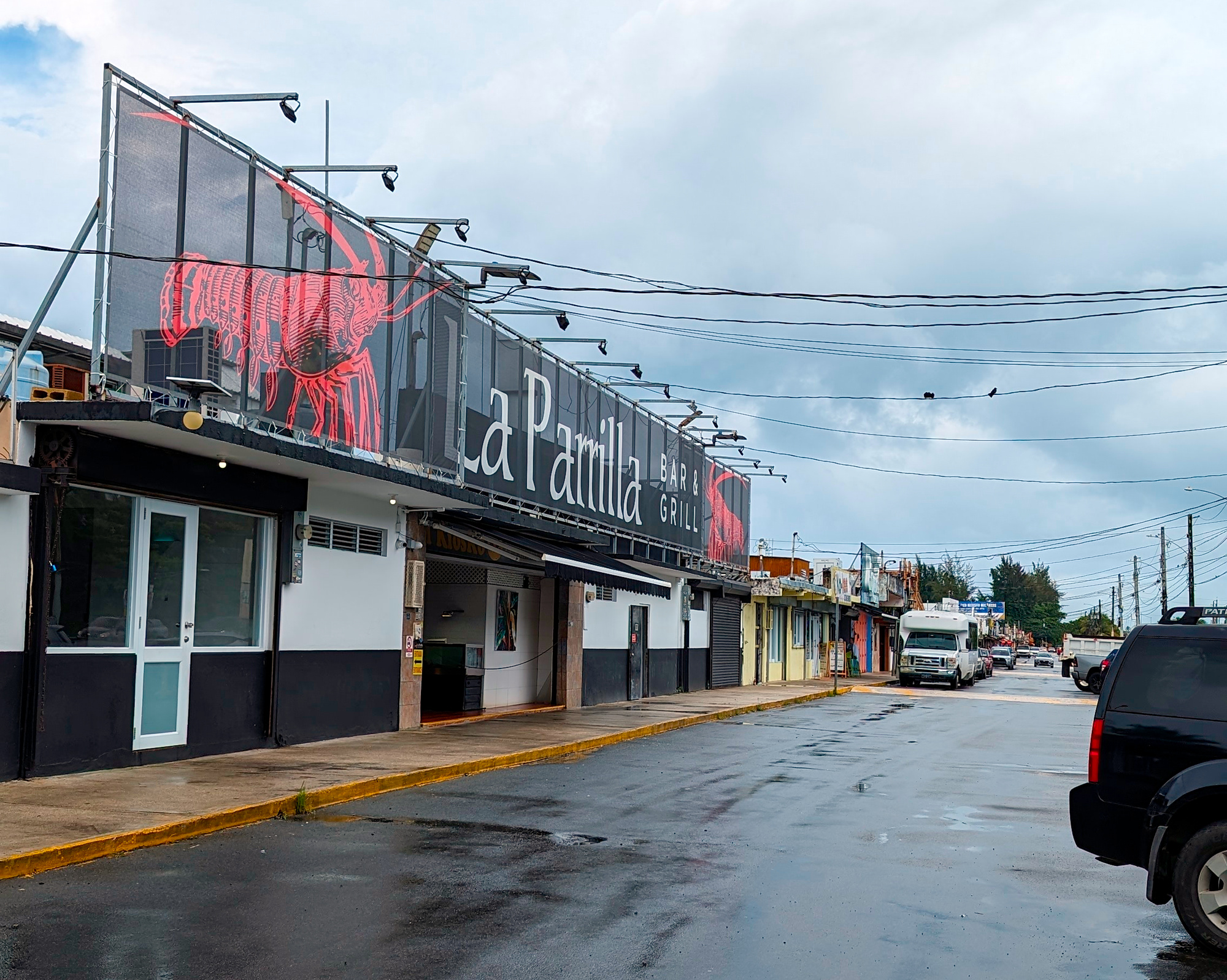
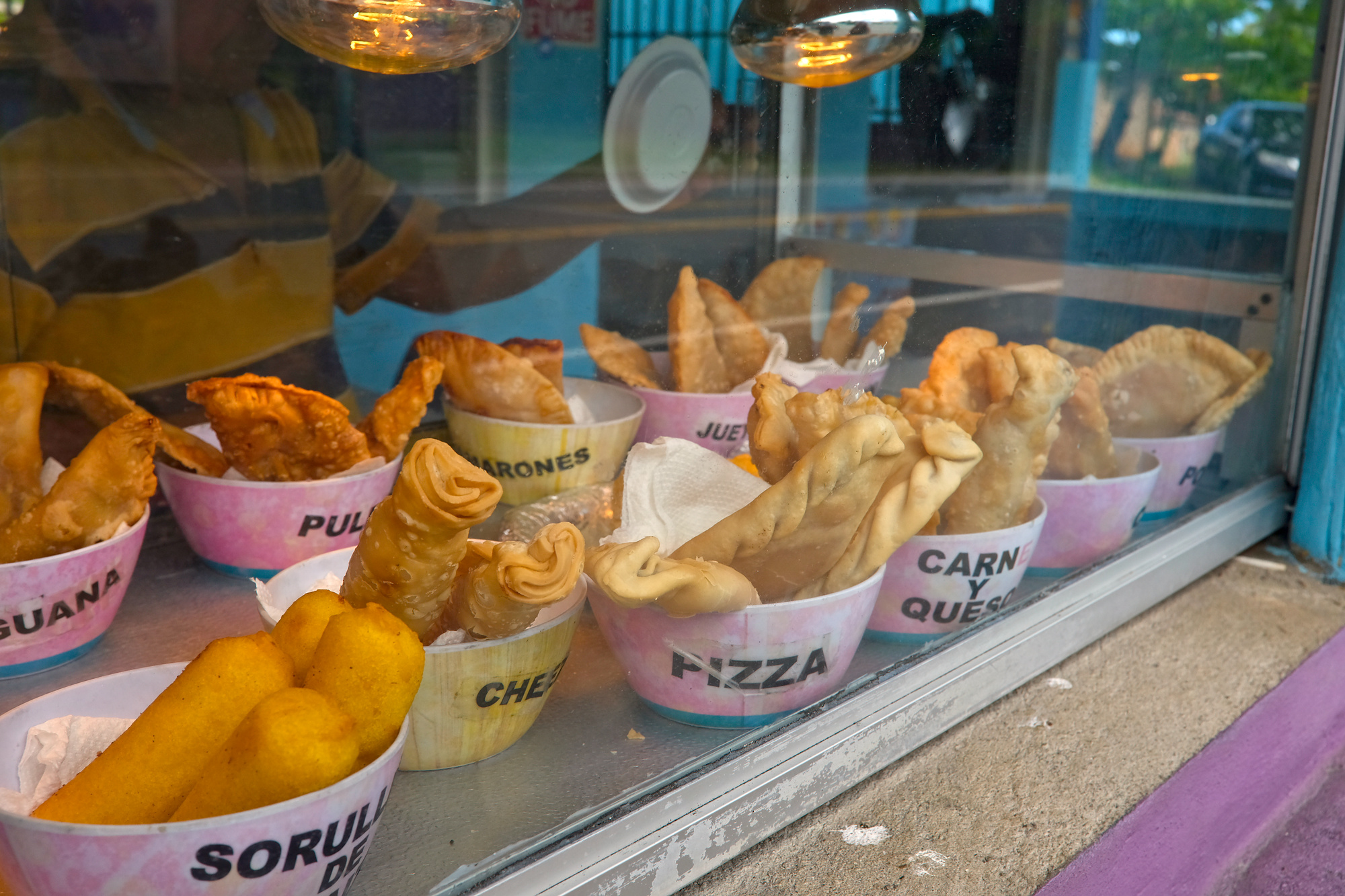
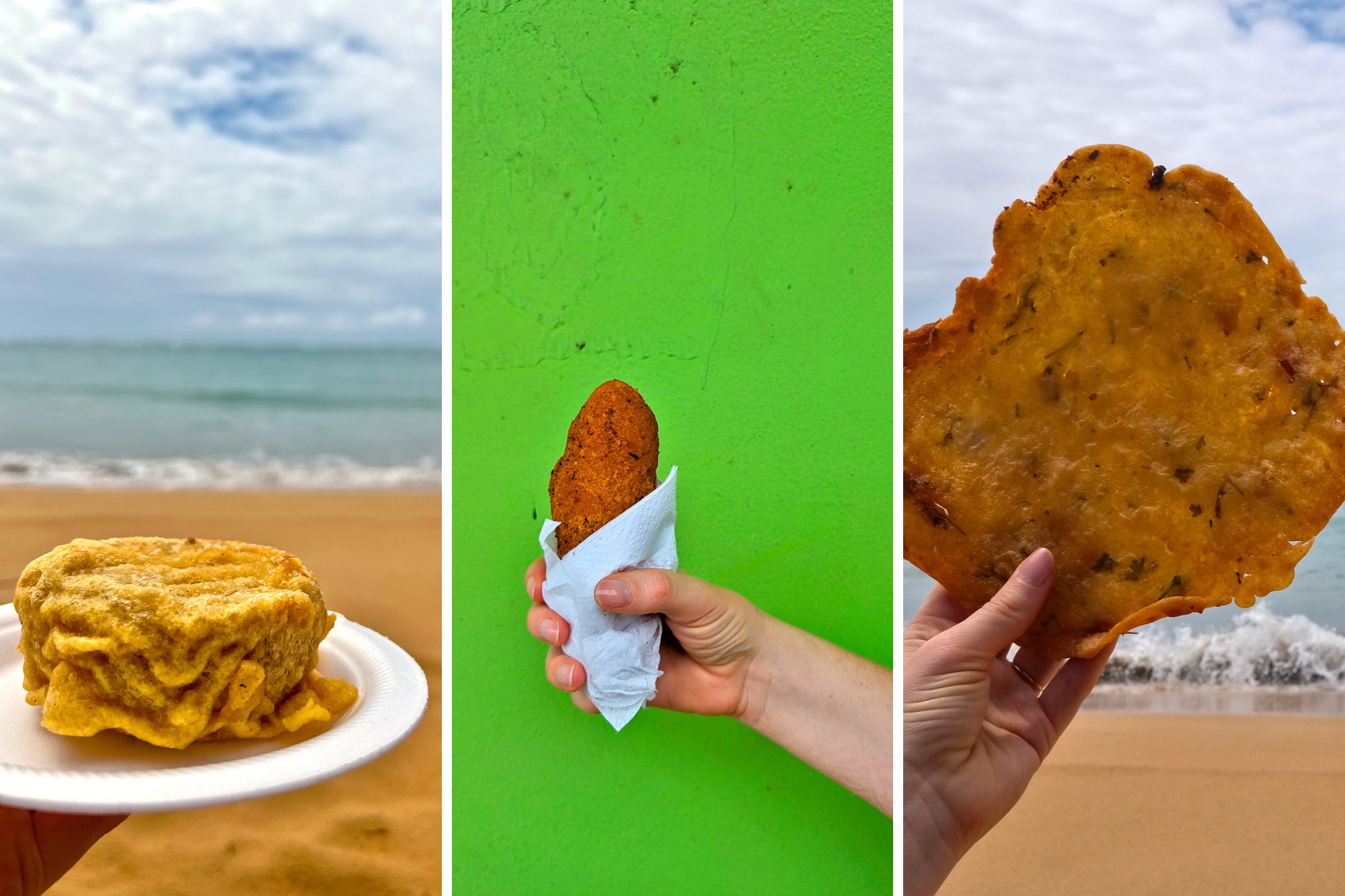
Los Kioskos
Picture this: you’re sitting on the beach, feeling sleepy from the sun (and perhaps from a pouch of Gasolina…) and your stomach starts growling. Rather than dealing with the hassle of packing a picnic for the beach, you’ll find a series of kioskos ready to fuel your beach hangs with local favorite dishes.
The Kioscos Municipales de Piñones are a popular stop given their proximity to San Juan, and you’ll find stalls lining PR-187. I had high hopes of bringing you several recommendations, however, most of the stands are closed during the week and my Tuesday visit left me nearly empty-handed. One sole vendor was open and slinging the fried goodies in the middle photo above, which we gratefully ordered and ate on the beach.
Thankfully, more of the options were open at Kioskos de Luquillo, even on a Monday. Some of these kioskos are better as a grab-and-go snack, and others are full-service. La Parilla was a particular favorite for a midday mojito break.
As always when you’re searching for street food, you’ll have the best luck at places that are busy. Not just because they’re probably popular for a reason, but because the food is being turned over at a higher rate and is likely fresher. You only have so many meals in a day, after all, why not make each one a good one?
→Kioskos de Luquillo // 97J7+8P9, Luquillo, 00773, Puerto Rico →Kioscos Municipales de Piñones // F23H+V62, PR-187, Carolina, Loíza 00772, Puerto Rico
—
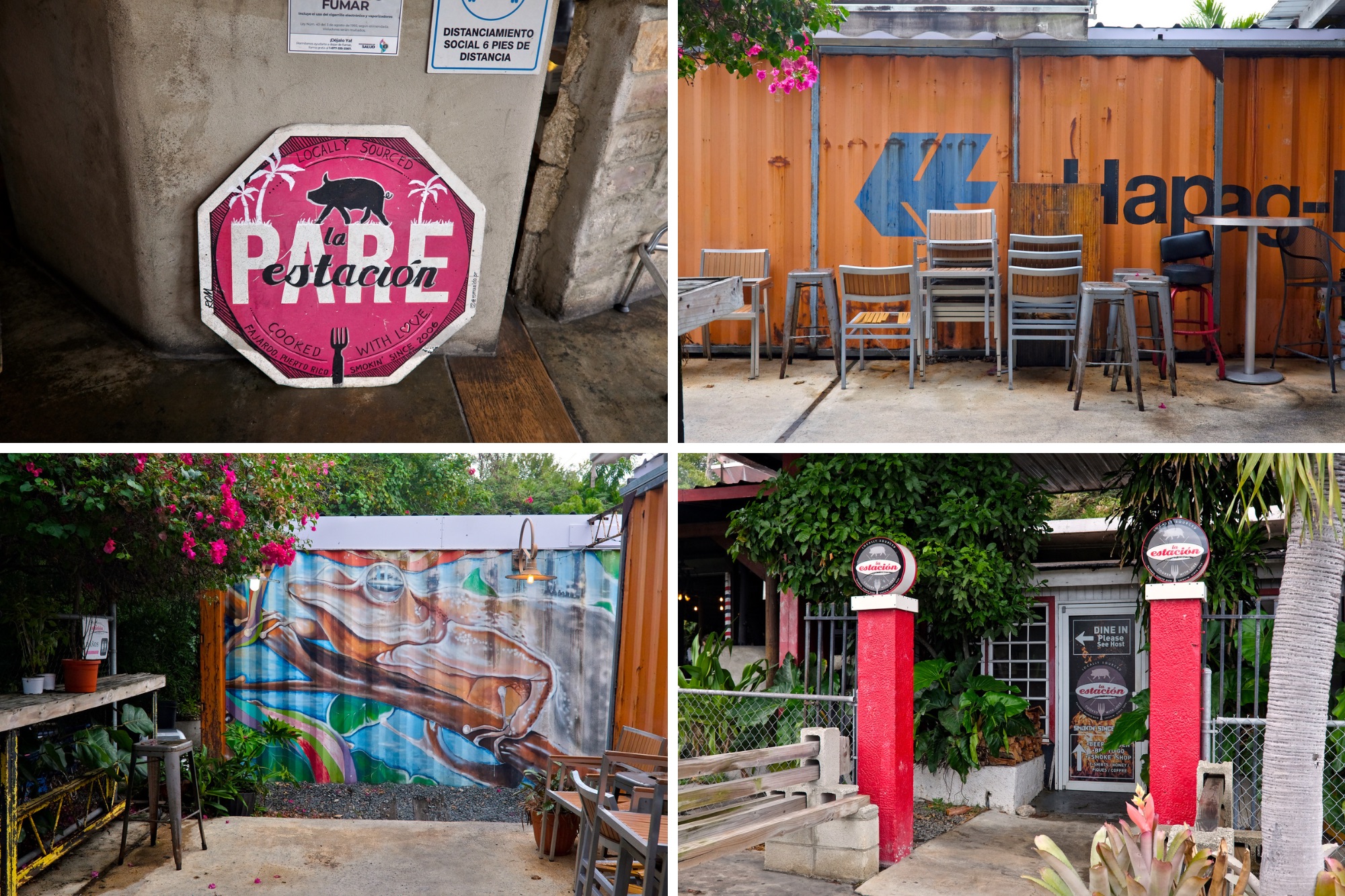
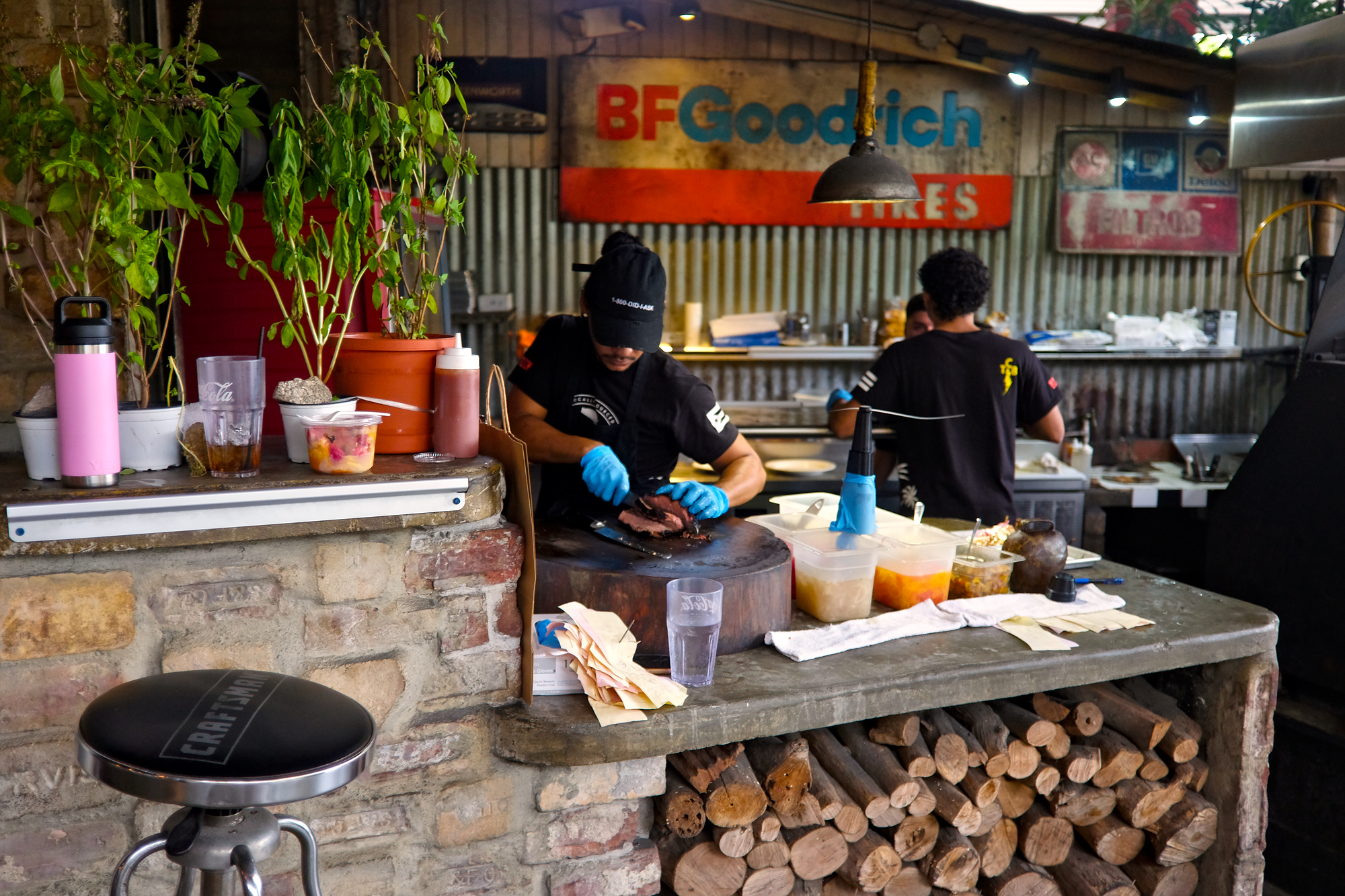
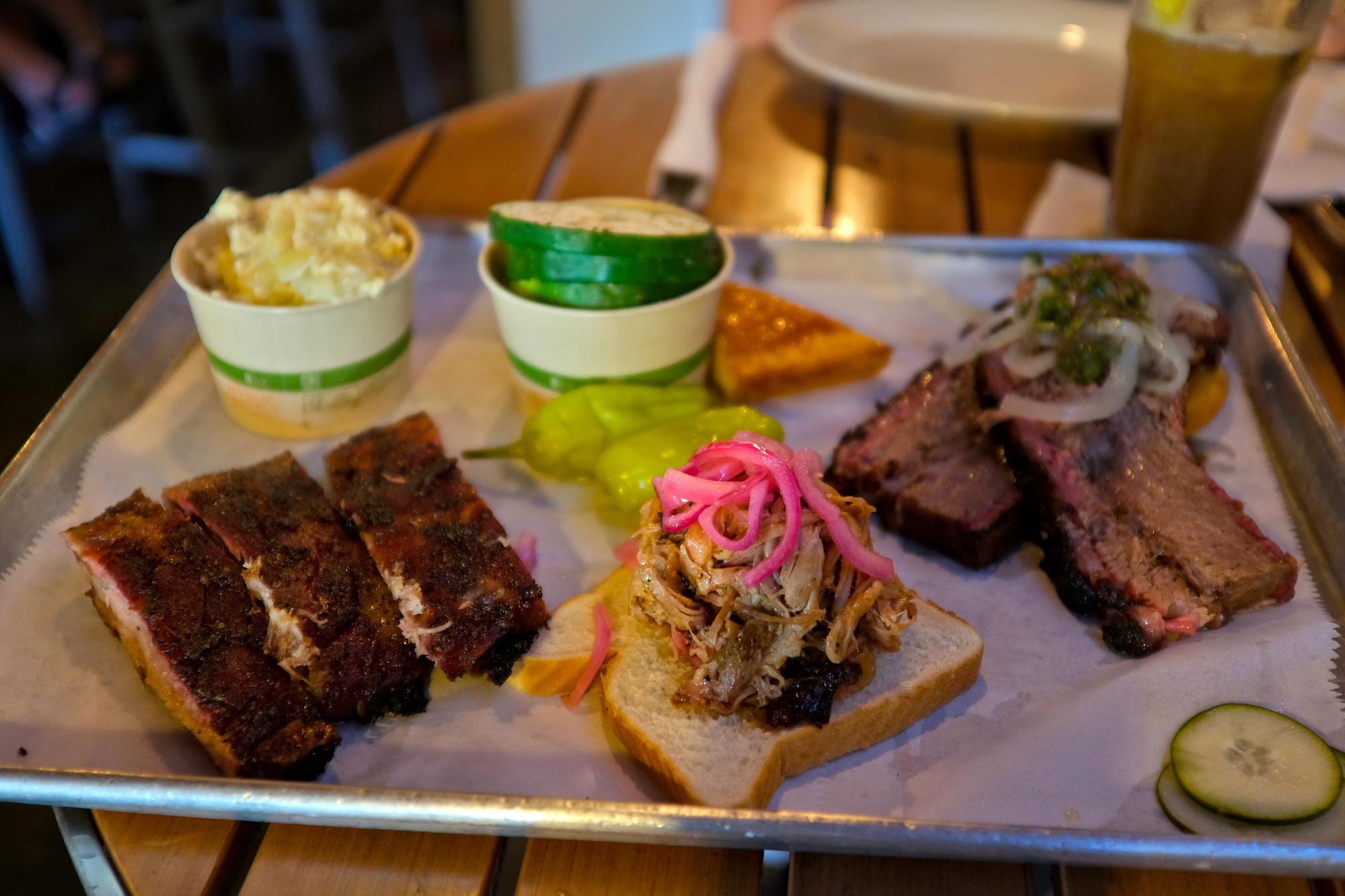
La Estación
I’m lucky to live in a region where good barbecue is easy to find (see examples one and two for proof), but that didn’t stop me from adding La Estación to my travel itinerary (and it shouldn’t stop you, either).
La Estación calls the meats coming out of their smokers “Nuyorican BBQ,” inspired by traditional cooking techniques and regional flavors. The chalkboard menu is constantly changing, but the standout dishes include their tender smoked brisket, succulent pulled pork, and flavorful ribs.
Each bite is a testament to the team’s dedication to quality and a unique fusion of flavors; trust me, it’s worth the detour.
→La Estación // Fajardo, 00738, Puerto Rico
—
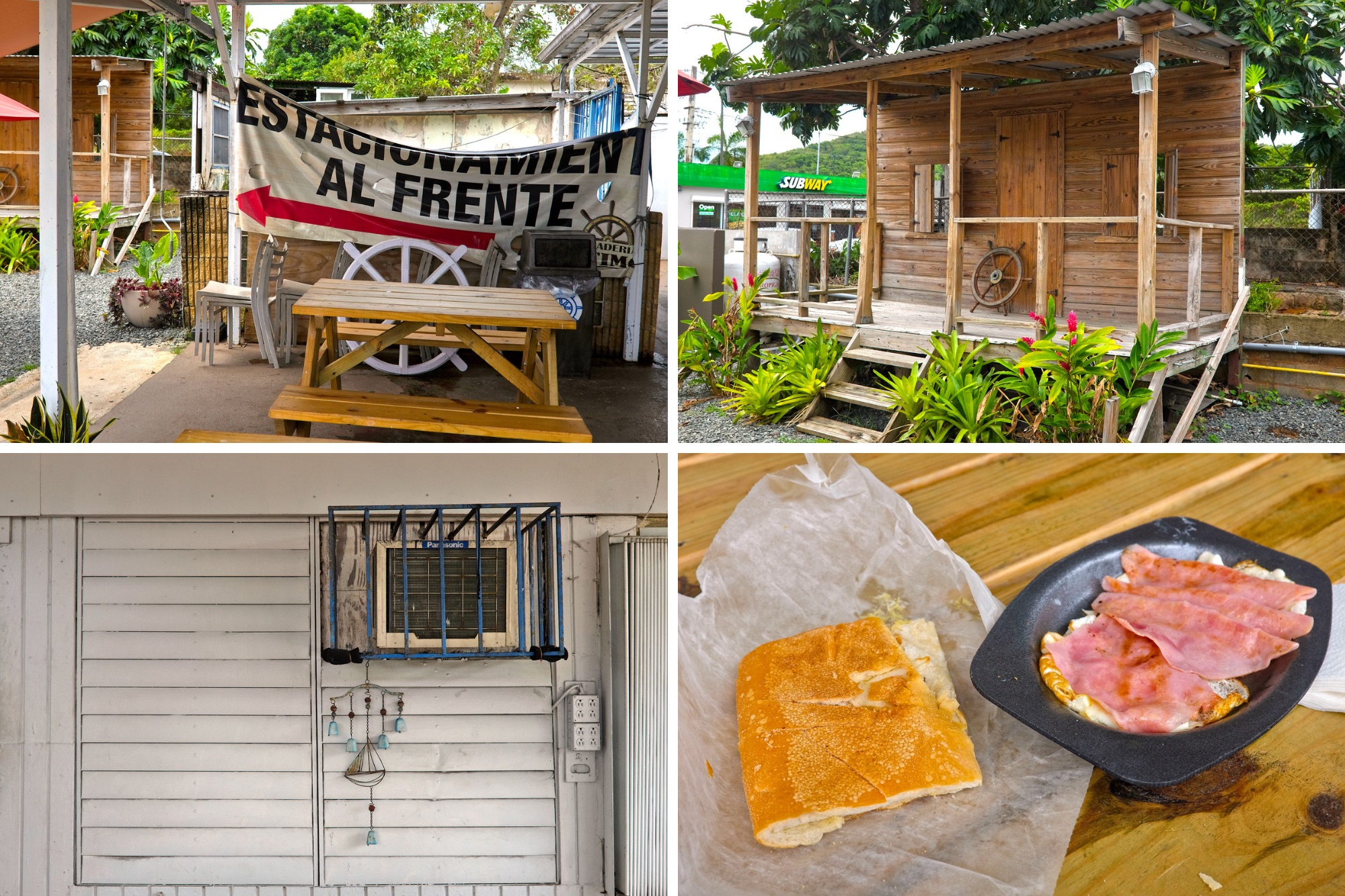
Panadería El Timón
For a truly local breakfast experience, head to Panadería El Timón in Fajardo. All of the Puerto Rican breakfast classics can be found on the menu, from cremas (porridges) to revoltillos (scrambles), and most dishes come with a side of their toasted homemade bread (note: generally speaking, in Puerto Rico, tostado/a will refer to toast and not the Mexican dish of the same name).
Place your order inside and head out to the covered picnic area to enjoy your breakfast before the heat of the day sets in. My huevos fritos con jamón was just the thing to tide me over until lunch, and I know Michael’s sandwich with jamón y queso must have been good because he didn’t offer me a bite.
→Panadería El Timón // Carretera 3, Fajardo, 00738, Puerto Rico
—
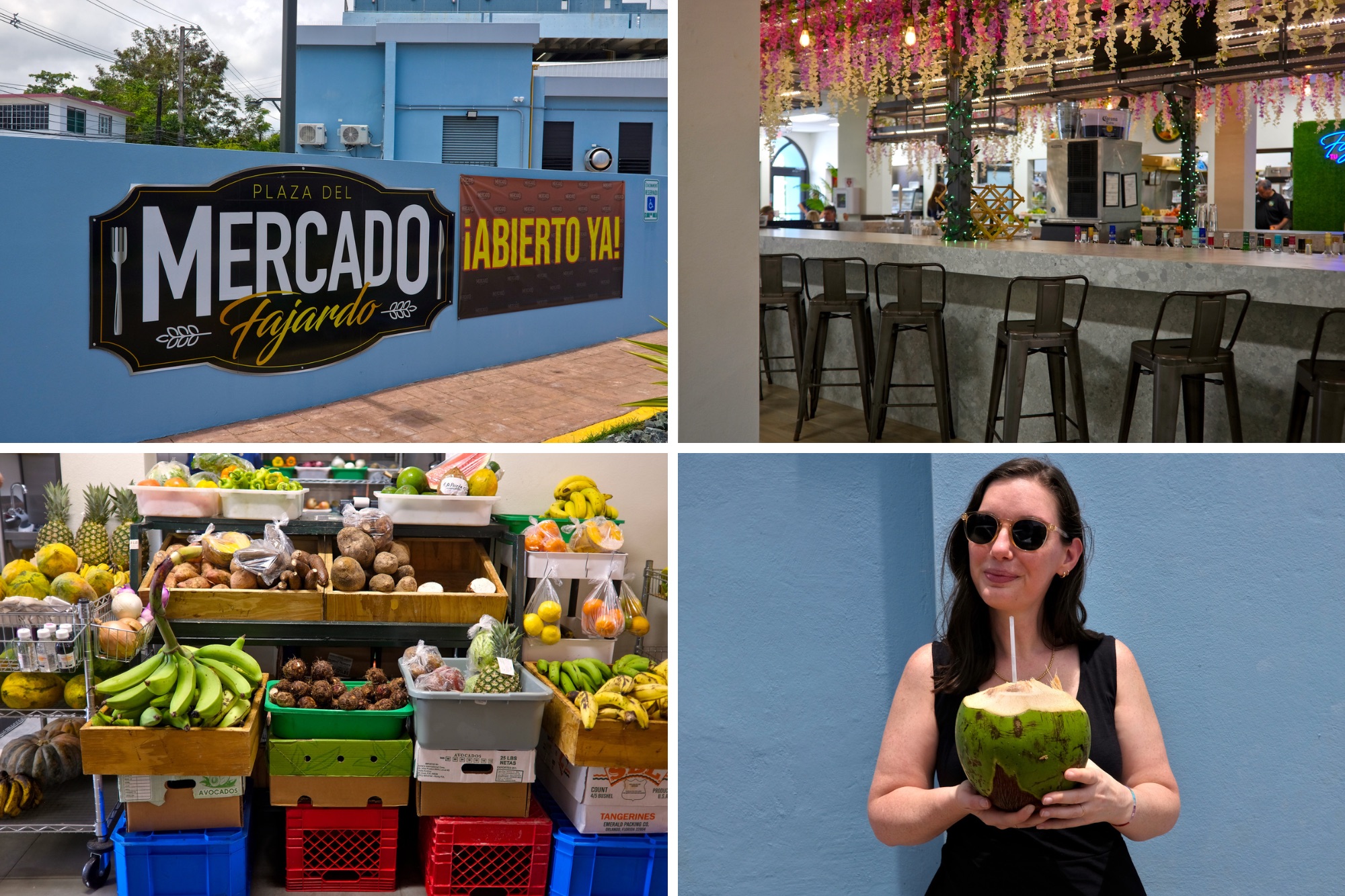
Plaza del Mercado de Fajardo
After an extensive renovation, Plaza del Mercado de Fajardo is now open just a few blocks off of Carretera 3. This market more closely resembles a hip food hall than an indoor farmers market, with prepared food stalls surrounding a chic bar in the middle, but there are a couple of produce vendors as well.
Now is as good of a time as any to talk a little about the availability of produce on the island. You might think a tropical paradise would have a fruit stand on every corner, but the reality is that agriculture is a particularly challenging industry, especially in Puerto Rico. To make things exponentially worse, the Jones Act places harsh restrictions on how goods can be imported to the island, driving up prices and reducing freshness. The takeaway? Support local agriculture at any chance you get.
→Plaza del Mercado de Fajardo // 88FX+C77, Cll Progreso, Fajardo, 00738, Puerto Rico
—
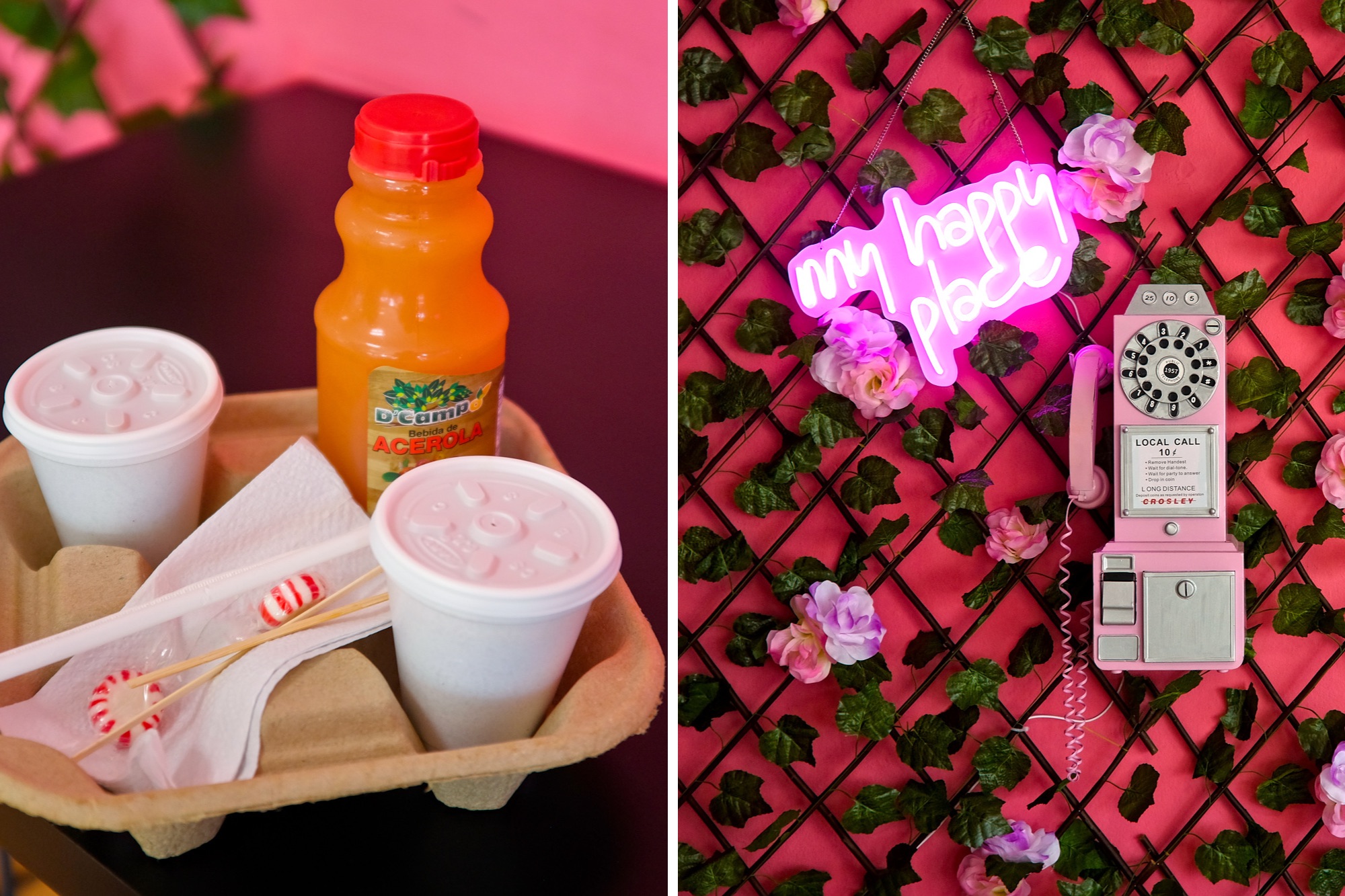
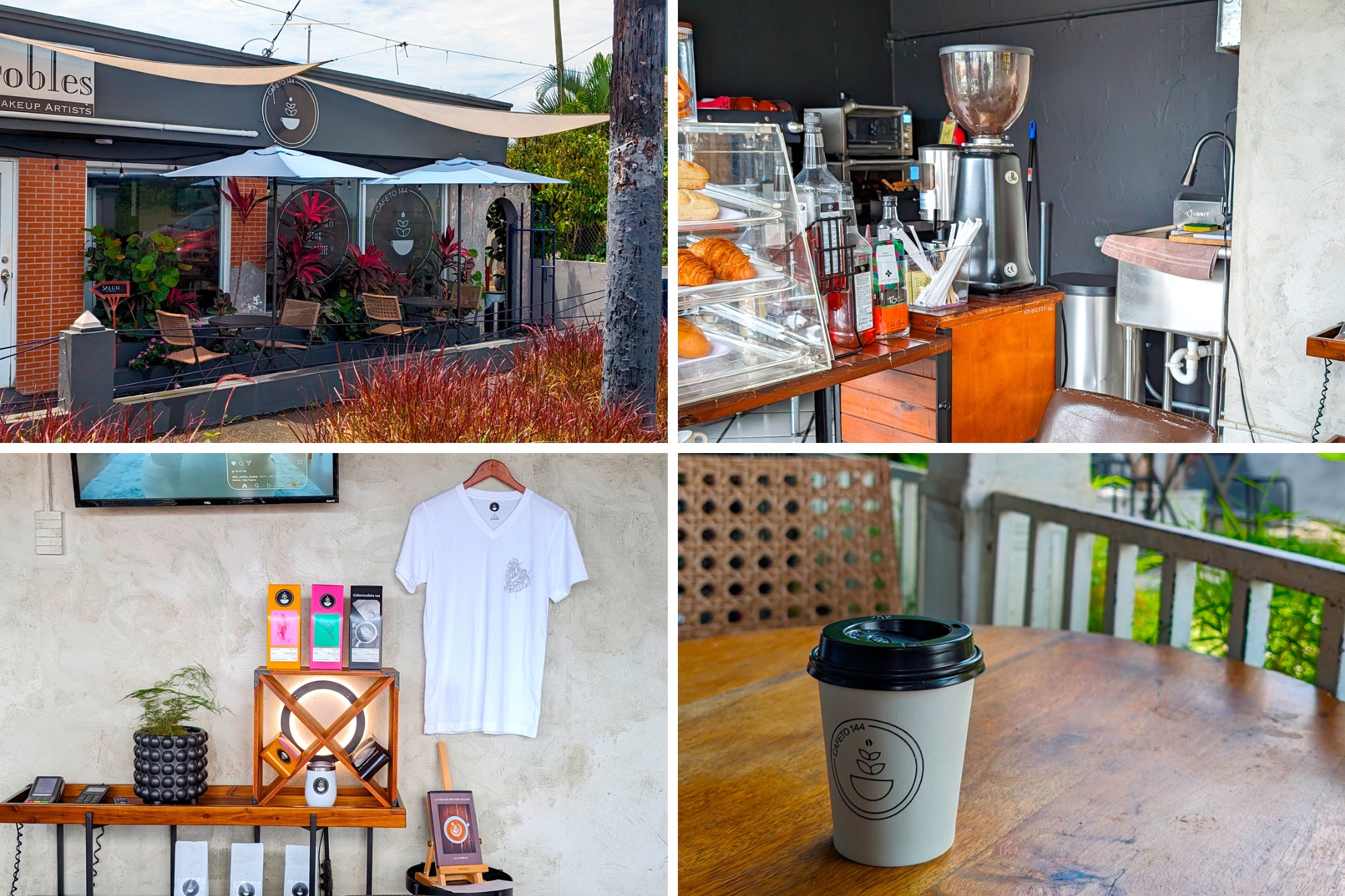
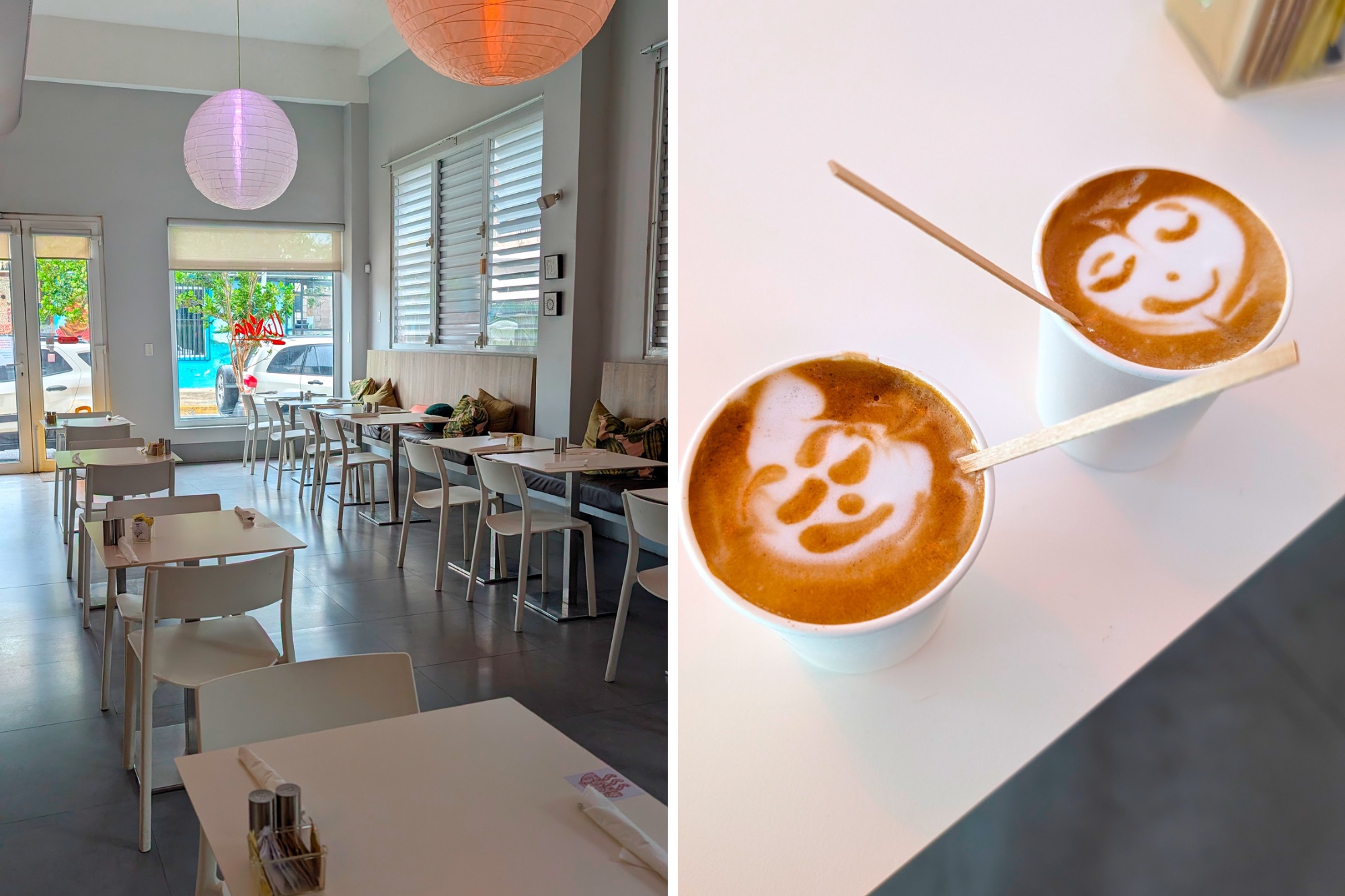
Coffee Shops
Maybe it’s not for everyone, but stopping for coffee is an essential part of the travel experience for me. Not only does the caffeine help keep me moving during a nonstop travel day, but a visit to a local coffee shop is a great way to capture the essence of the community.
Visitors to El Yunque will appreciate a post-hike pick-me-up from Lluvia Deli Bar & Artefacto, just minutes outside of the park entrance. This chic cafe serves a deli breakfast and lunch menu, plus pizza in the evening – but I only had eyes for coffee. And I’m so glad I did – how charming are our cortaditos above?
Over in Ceiba, I had the chance to visit two local coffee shops that I highly recommend. Although Doña Café is a relative newcomer to the town, it already feels like the neighborhood spot. Plus, all of the coffee at Doña Café is made from 100% Puerto Rican beans.
If, unfortunately, a portion of your time in Puerto Rico must be spent working, CAFETO 144 would make your day a little brighter. This coffee shop has a shaded courtyard and ample tables for lingering over a café con leche.
I noted this in my San Juan guide, but it’s worth a mention here, too: the vast majority of Puerto Rican coffee shops you visit will likely only serve espresso-based drinks. If your go-to brew is a drip coffee, it’s time to make the switch! An Americano or a cold brew (when offered) will be your closest options.
→CAFETO 144 // 144 Ave Lauro Piñero, Ceiba, 00735, Puerto Rico →Doña Café // 260 Av. Lauro Piñero local B, Ceiba, 00735, Puerto Rico →Lluvia Deli Bar & Artefacto // 52 Principal Street, Río Grande, 00721, Puerto Rico
—
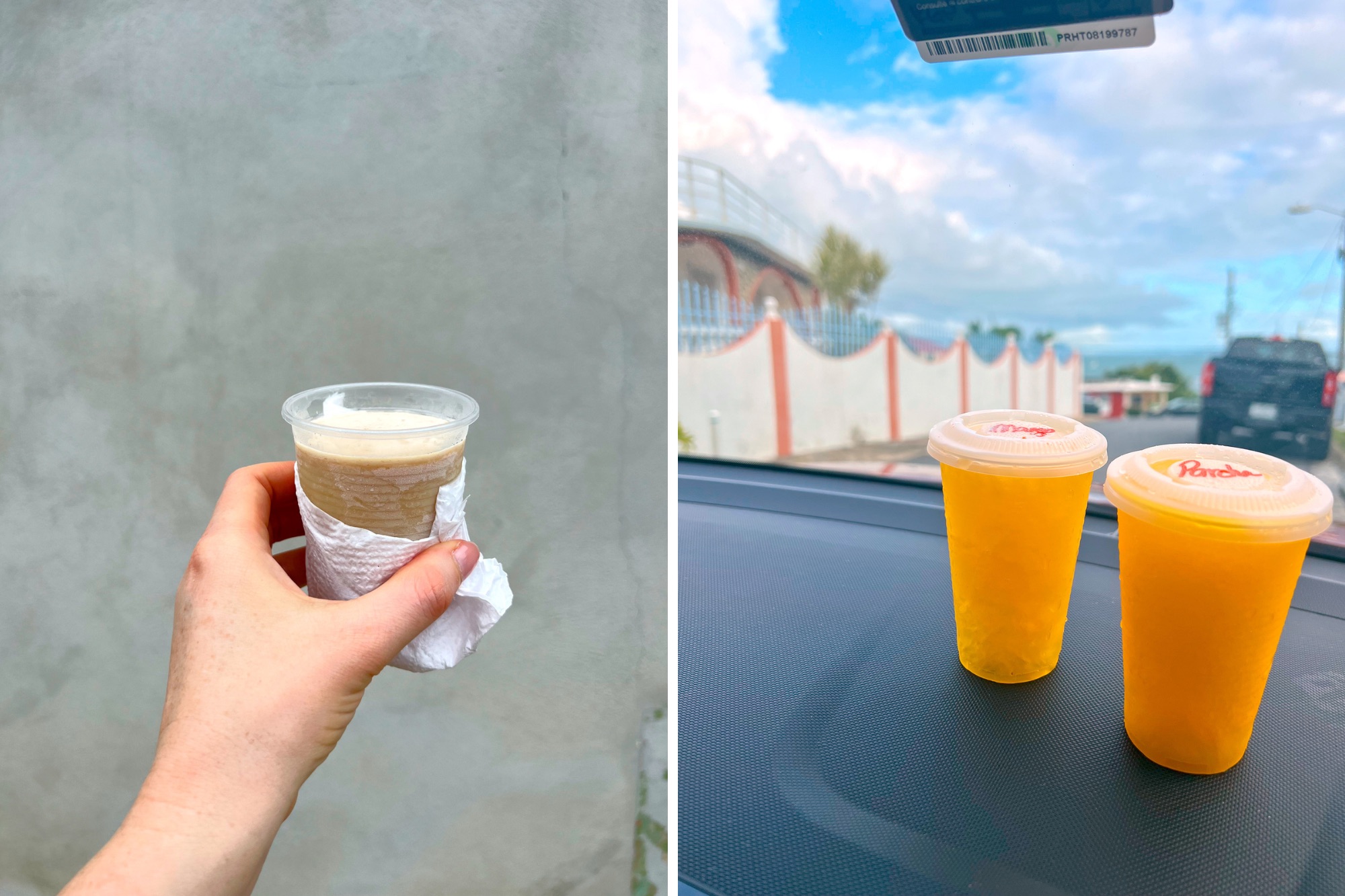
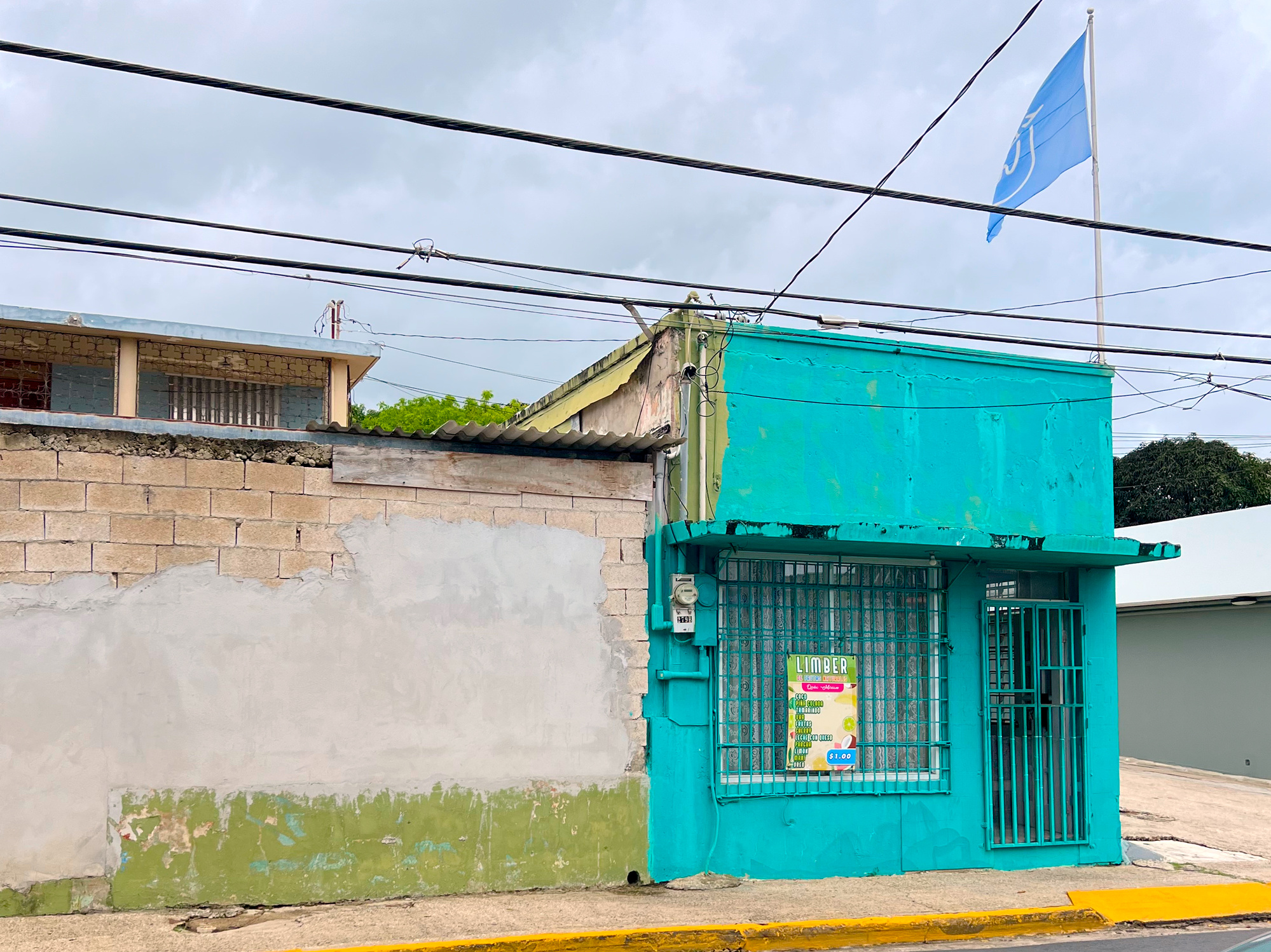
Limber
On a hot day in Puerto Rico, nothing beats an icy limber. It’s commonly believed that this frozen treat got its name after the pilot Charles Lindbergh enjoyed the treat during his visit to the island in 1928, not that it really matters when you’re in need of some cool relief.
You can easily find these ultra-sweet icy treats in local flavors at convenience stores and gas stations, but to me, a limber is best served from someone’s home (or perhaps I’m just nostalgic for our stop at Rosa’s Booth in St. Croix). Locals surely know where all the limber spots in town are located, but thankfully for the rest of us, many of them are easily found on Google Maps.
I had the chance to visit two on the East Coast and would have gladly returned to both if time allowed. In Ceiba, Limber De Miriam is along a busy street in a vibrant blue home, serving up flavors like tamarind and mani (peanut) from her living room. Over in Fajardo, you’ll likely be greeted by Wilma at the front door of Limber De Wilma. At the end of the day, there were only a few flavors left, but I can’t imagine how any others could possibly be better than our mango and parcha (passion fruit) limber.
→Limber De Miriam // 279-281 Carretera 3, Ceiba, 00735, Puerto Rico →Limber De Wilma // 998G+Q3Q, Fajardo, 00738, Puerto Rico
WHERE TO STAY
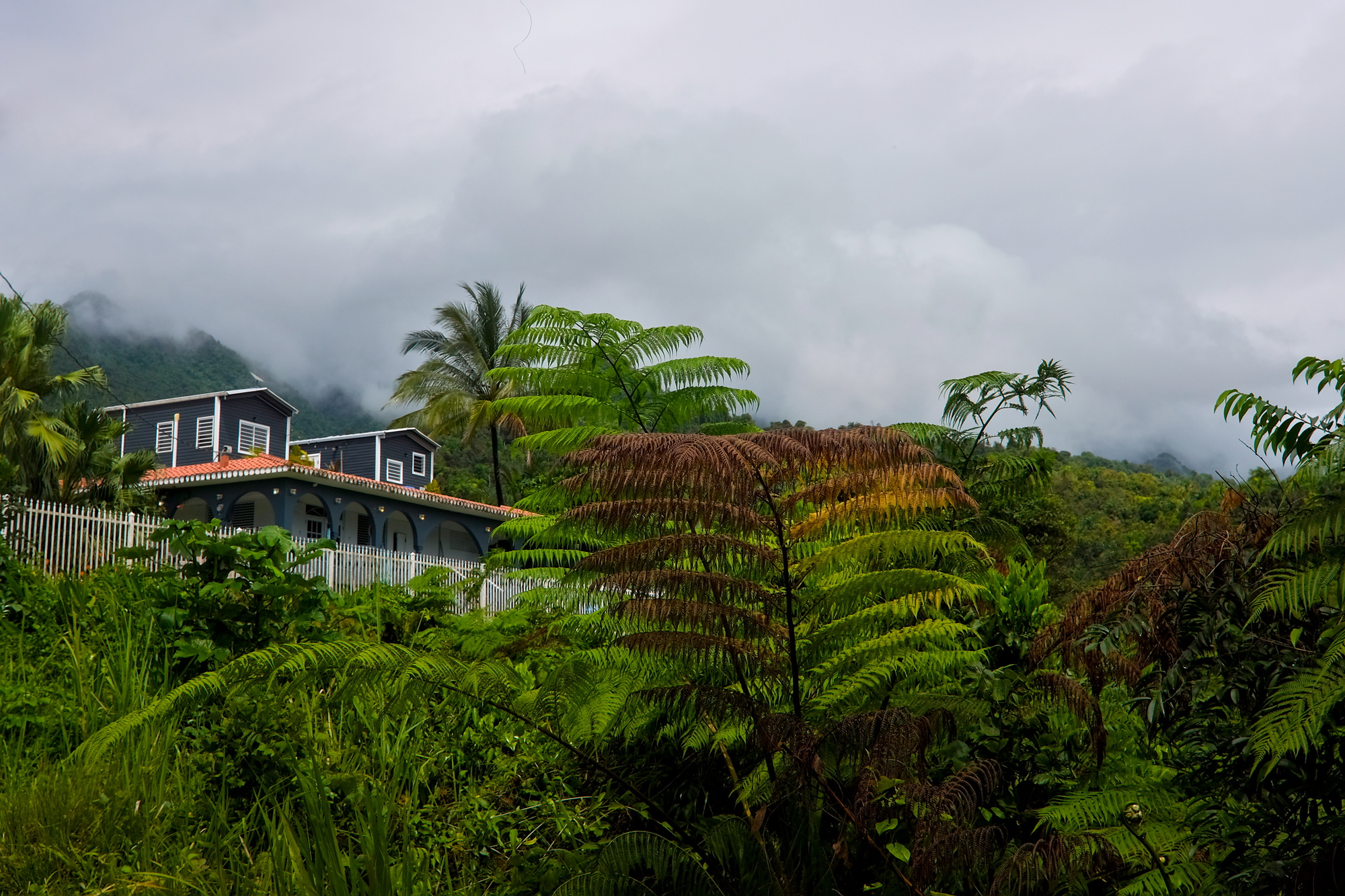
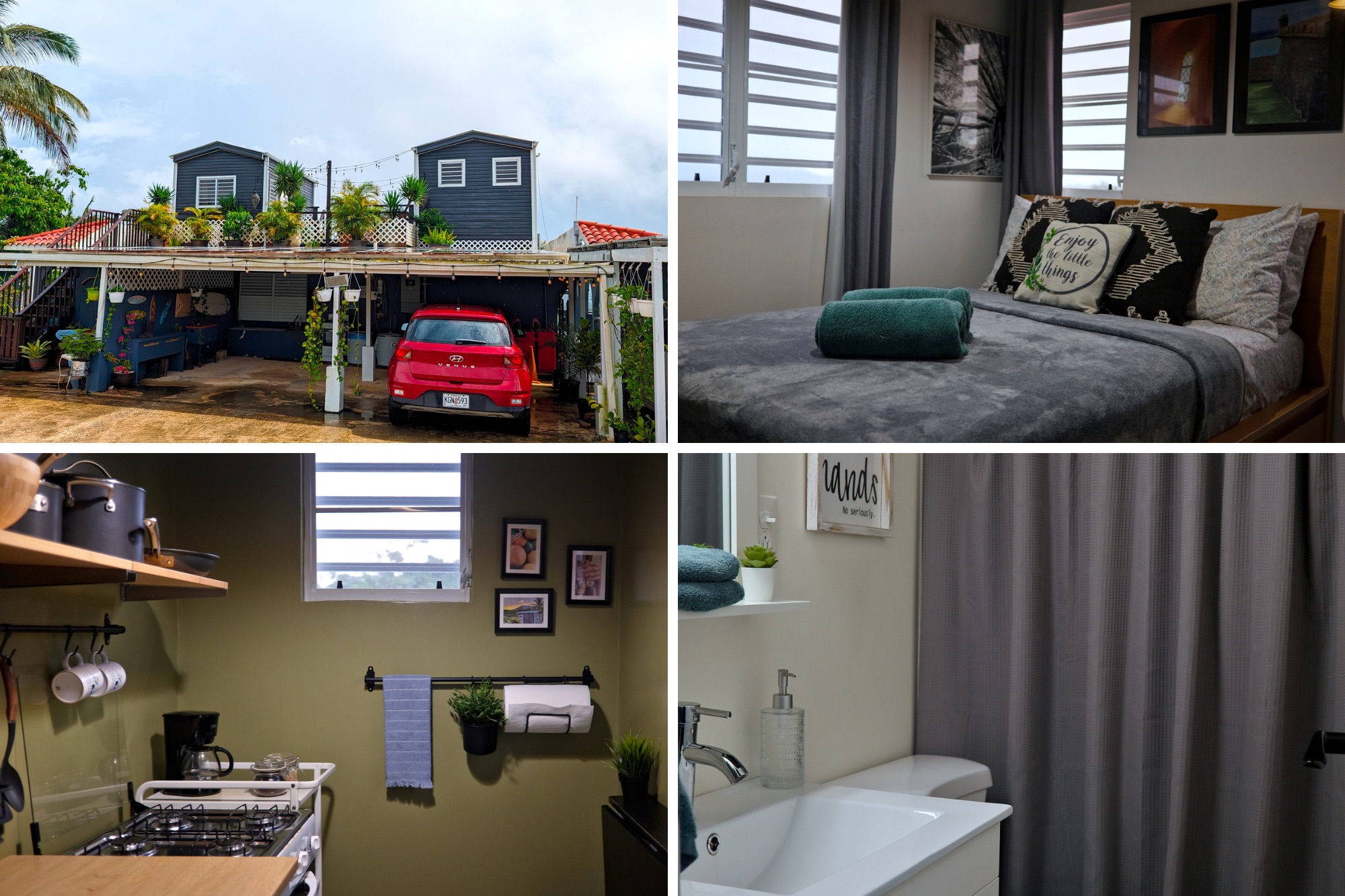
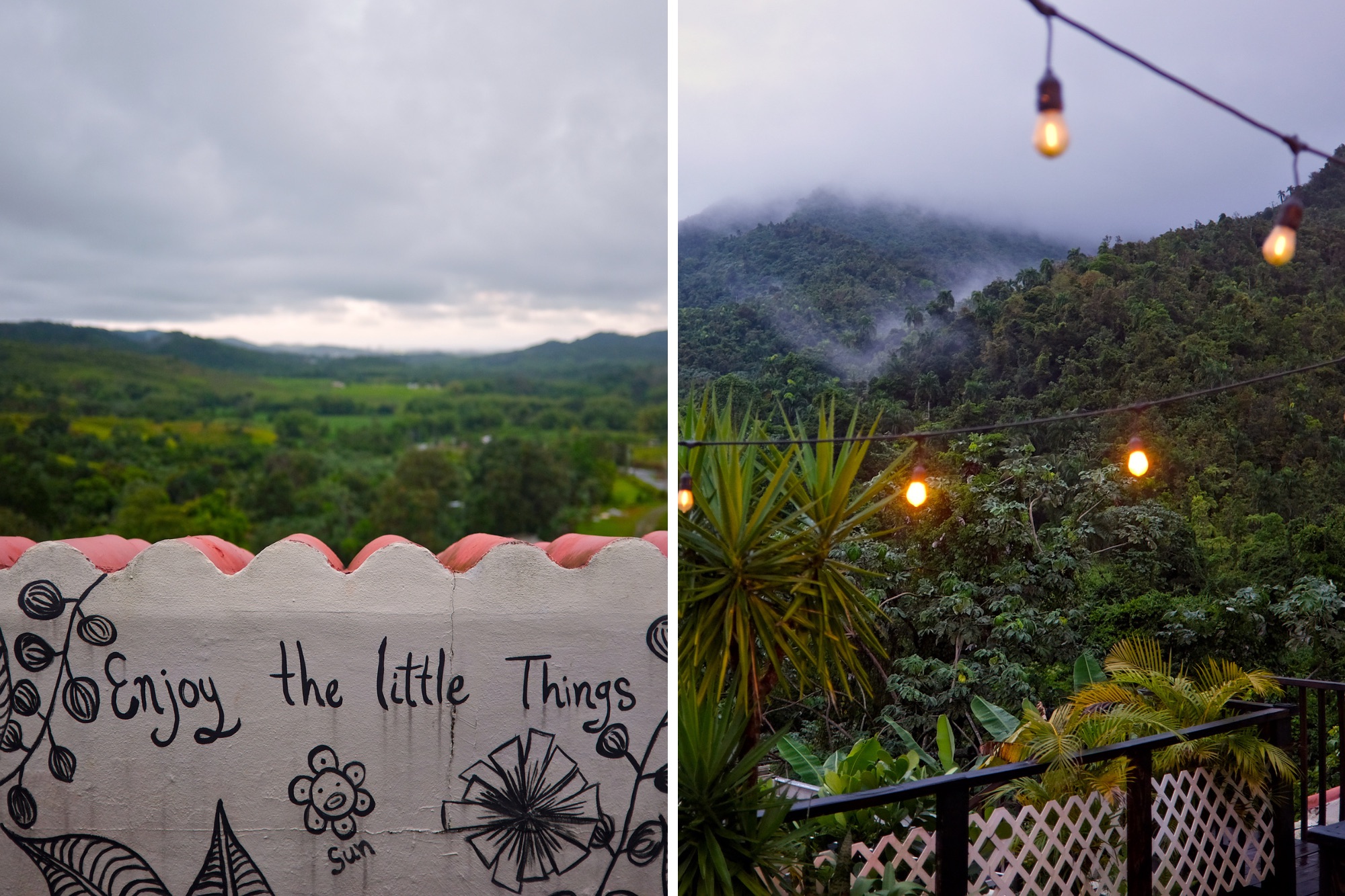
Hacienda Catalina
The impacts of development on the environment are felt throughout Puerto Rico, particularly along its beaches and in the rainforest, so it is imperative for us as visitors to choose our lodging sustainably. Rather than opting for a sprawling all-inclusive resort, consider options with a smaller footprint.
The rainforest is lush with choices, and Michael and I considered local, eco-friendly lodging like The Serene House, Yuquiyú Treehouses, and Rainforest Inn for our stay. Ultimately, though, the budget won out and we settled on Hacienda Catalina for the location and value.
This duo of tiny homes is located atop a local family’s residence on the border of Ceiba and Naguabo, and it makes a great home base for all of the activities in the guide. In addition to being, well, tiny, the tiny homes are fully self-sufficient, running on solar power and filtering water for consumption. Each is outfitted with a comfortable bed, a small kitchen, and a full-sized bathroom with a walk-in shower, but my favorite part of our stay was sitting outside on the porch and listening to the songs of the coquí frogs in the evenings. You can find Hacienda Catalina on Airbnb.
→Hacienda Catalina // Address provided by host
WITH MORE TIME ON THE EAST COAST
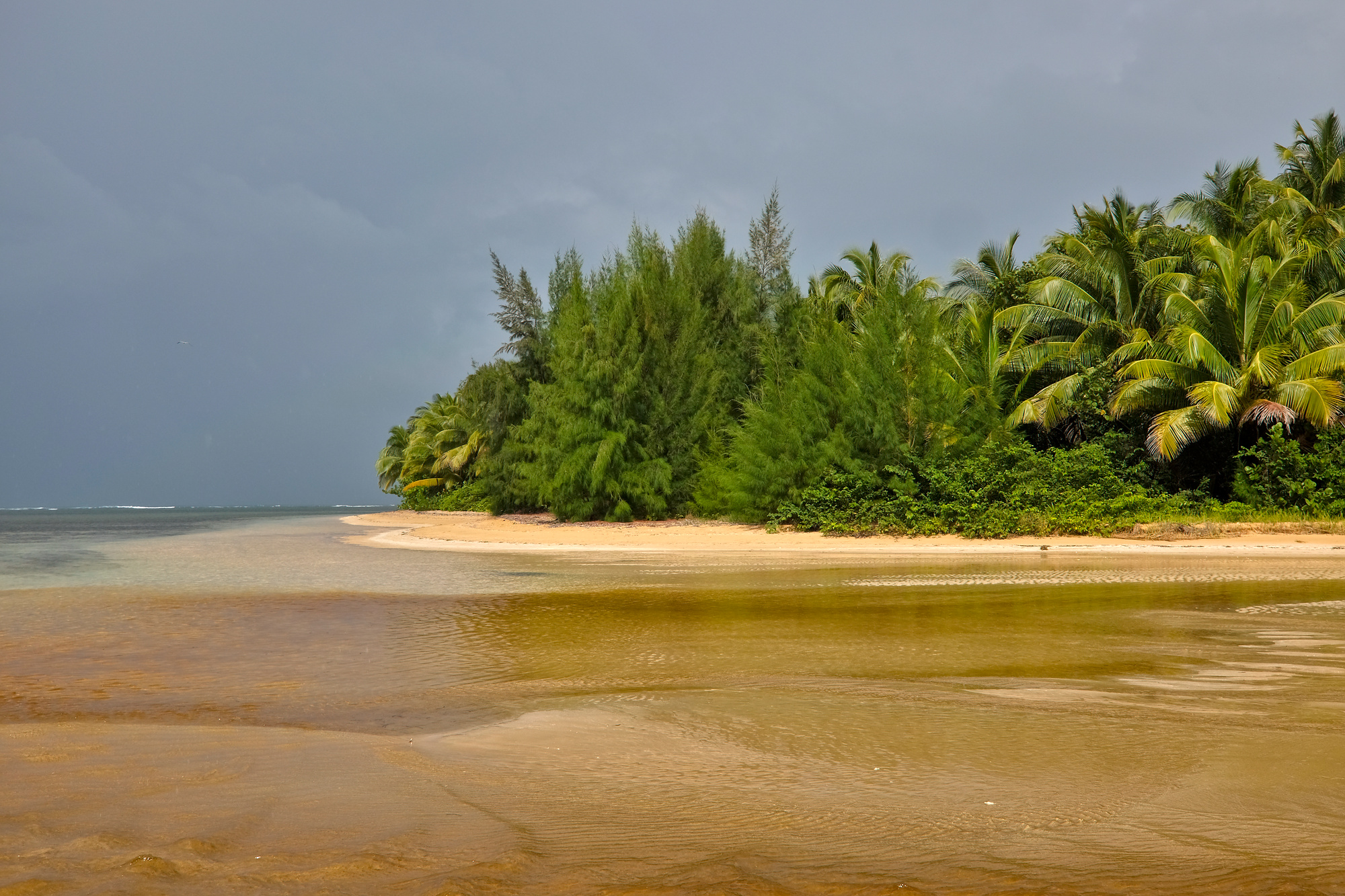
Thinking about extending your stay? I swear I’m not jealous…
Not to jump the gun, but I’m already planning my next stops to this region, including:
- Exploring local farms like Finca Neo Jibairo, La PruVite, or Hacienda Muñoz
- Stumbling upon hidden beaches
- Spending more time at waterfalls and swimming holes
- Heading for the islands of Cayo Icacos, Vieques, and Culebra
- Dining at local places like El Oceano en tu Mesa, Noelia’s, El Chinchorro de Tía Manin, BACOA Finca + Fogón
As always, if you make it to any of these places before I do, please leave a comment – I’d love to hear your thoughts!
TRAVEL TIPS FOR EXPLORING EASTERN PUERTO RICO
Many of these points echo my San Juan travel tips but are worth sharing here as well
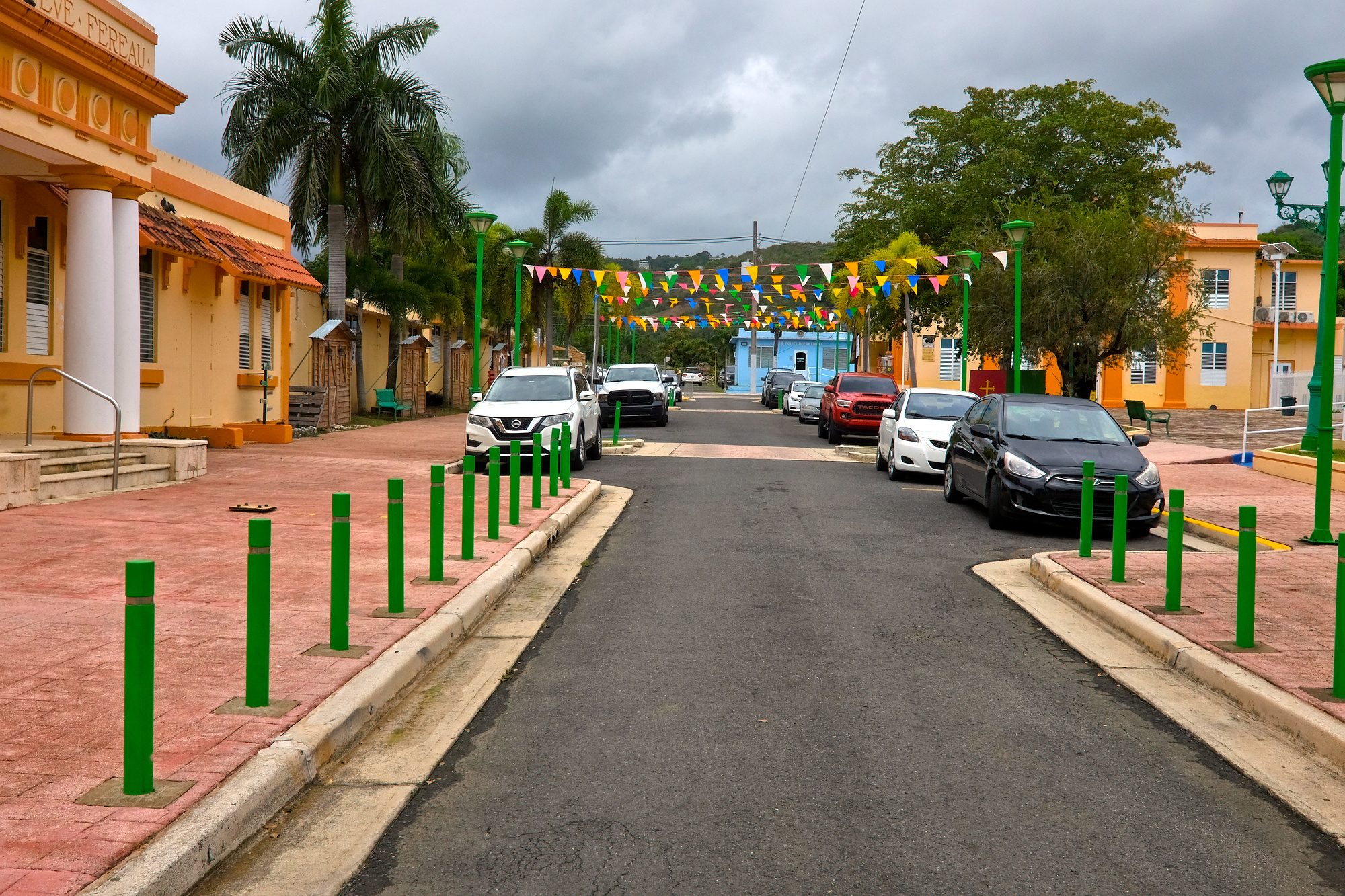
How to get around
Unless you’re able to hire a private driver or prefer to take a guided tour experience, you will need a car to explore this part of Puerto Rico. Somewhat surprisingly, we did not need four-wheel drive at all for the trip; in fact, a smaller car was better in many cases as the back roads are quite narrow.
Google Maps works well for navigation, but be sure to download offline maps before you leave home in case you find yourself without signal. One small note: the location of restaurants and local businesses may not be accurate on the map; I found it most helpful to pull up photos of the establishment to pinpoint its exact location. Find more advice for renting a car and driving in Puerto Rico in this post.
Pack wisely
My packing list post is in the works, but there are a few non-negotiables that may not be on your radar that I should mention right away. For the rainforest, you’ll need a pair of waterproof sneakers/boots, a rain jacket, clothes that can get muddy and dry fast, and bug spray (to be honest, I didn’t need the last one, but I’m so glad I had it just in case!). For the beach, be sure to bring a cover-up for your excursions to the kioskos, a quick-dry towel, and reef-safe sunscreen.
Visit responsibly
We all want paradise to stay paradise forever, right? We should all strive to be good stewards of the places we are visiting: don’t leave trash behind, don’t mess with the wildlife, and choose to eat and support local whenever possible.
Safety
I found this region safe and comfortable to visit, but you should always take precautions. Never attempt a hike that you’re unsure if you can complete, don’t swim in dangerous conditions, and drive carefully. I want you to be able to return to the island again and again!
FINAL THOUGHTS ON VISITING PUERTO RICO’S EAST COAST
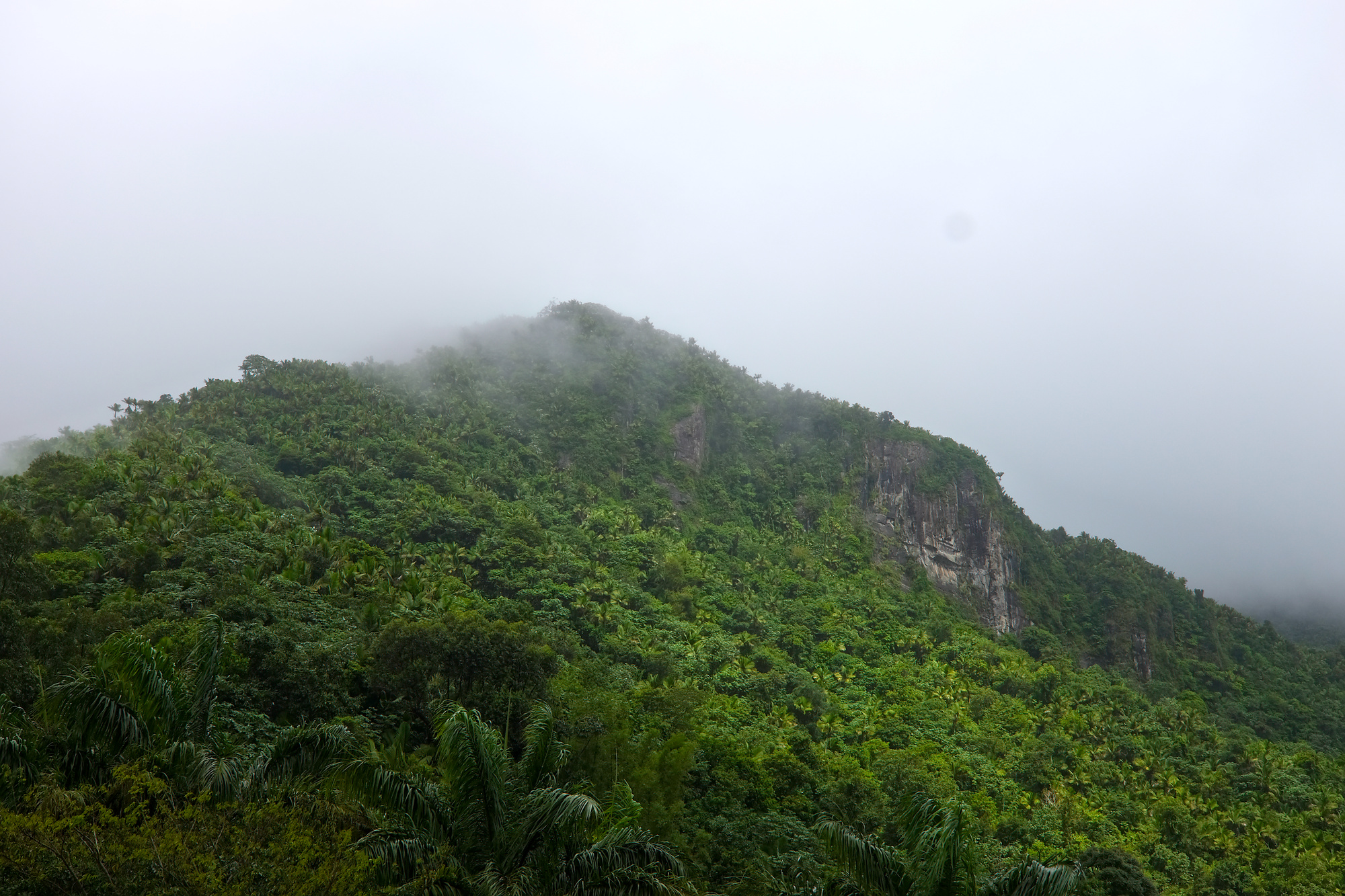
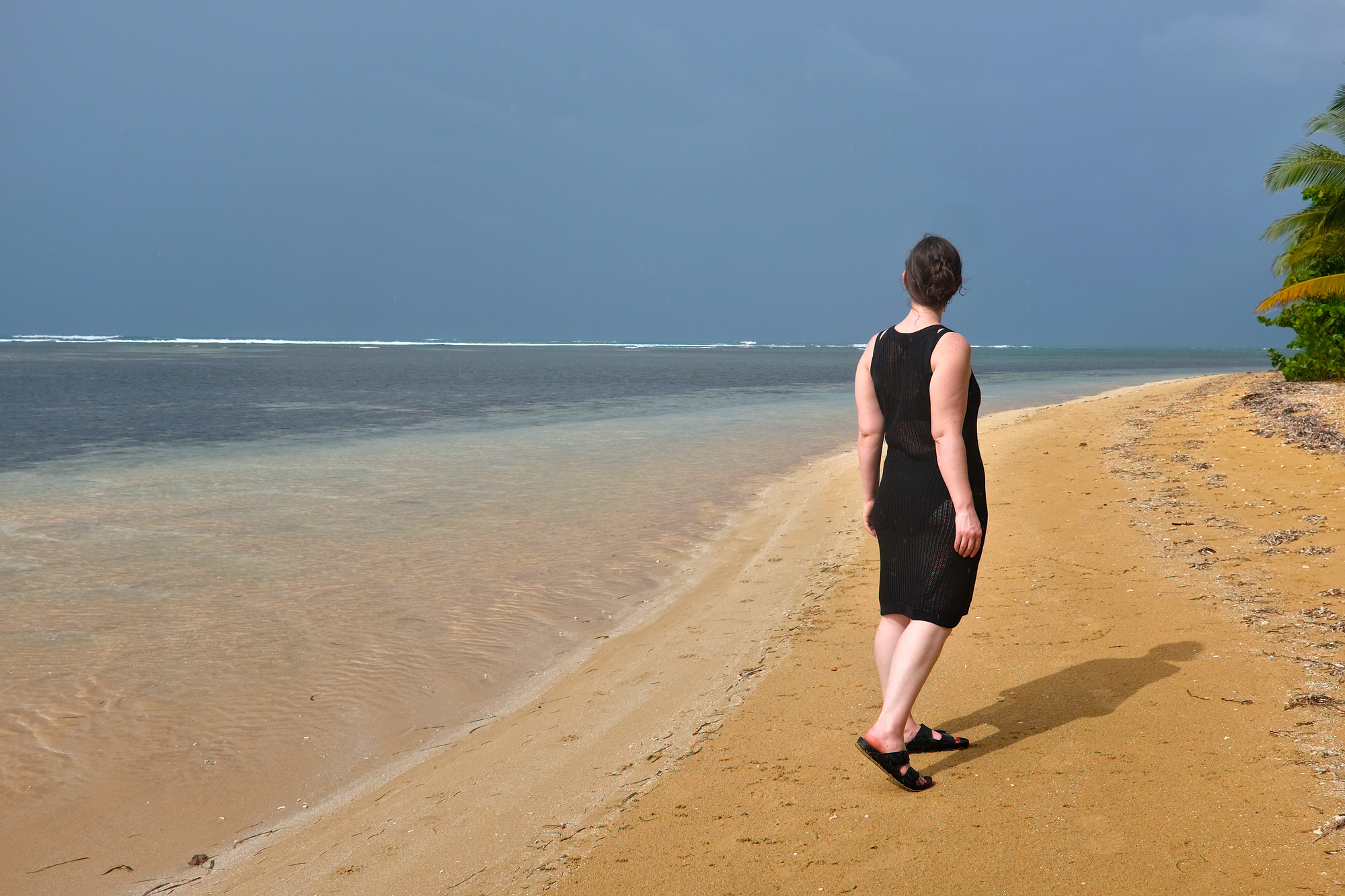
This region is so diverse that at first, it felt odd to combine the rainforest and beaches in one post – except it’s only a fifteen-minute drive from the entrance of El Yunque to the nearest beach. How incredible is that?
It would be easy to spend a week or longer in the area, lingering at the beach, strolling the towns, and embarking on longer hikes, but even a two-night stay offers plenty of time to slow down and enjoy the island’s natural beauty. I sincerely hope that you’ll take the opportunity to wave goodbye to San Juan for a little while and be embraced by the enchanting natural landscape.
—
Questions for you
Quick, pick one: beach or rainforest?
Which dish are you most looking forward to trying at the kioskos?
Did I miss any of your favorite spots? Let me know!
Where to next? You may also enjoy these other guides:
- 13 Things You Should Know Before Renting a Car in Puerto Rico
- Weekend Escape: The Ultimate Guide for Your First Visit to San Juan, Puerto Rico
- Culinary Paradise: A Review of Marmalade in San Juan, Puerto Rico
- Checking In: A Review of Dream Inn in San Juan, Puerto Rico
- Checking In: A Review of El Colonial Hotel in San Juan, Puerto Rico
- Traveling Light: A Packing List for Five Nights in San Juan, Puerto Rico
- Four Days in St. Croix Travel Guide
- Traveling Light: St. Croix Packing List
- Travel Guide: Four Days in Cartagena, Colombia
- Rosario Islands Day Trip: A Review of Islabela Eco Resort
- Traveling Light: Cartagena, Colombia Packing List
- 13 Things You Should Know Before You Book a Flight with Avelo Airlines
- 14 Things You Should Know Before You Fly Frontier Airlines for the First Time
- 15 Things Travelers Should Know Before Flying Spirit Airlines for the First Time
- Travel Guides by Destination
- My Travel Essentials
- Shop My Closet
- Exclusive Discounts + Promo Codes
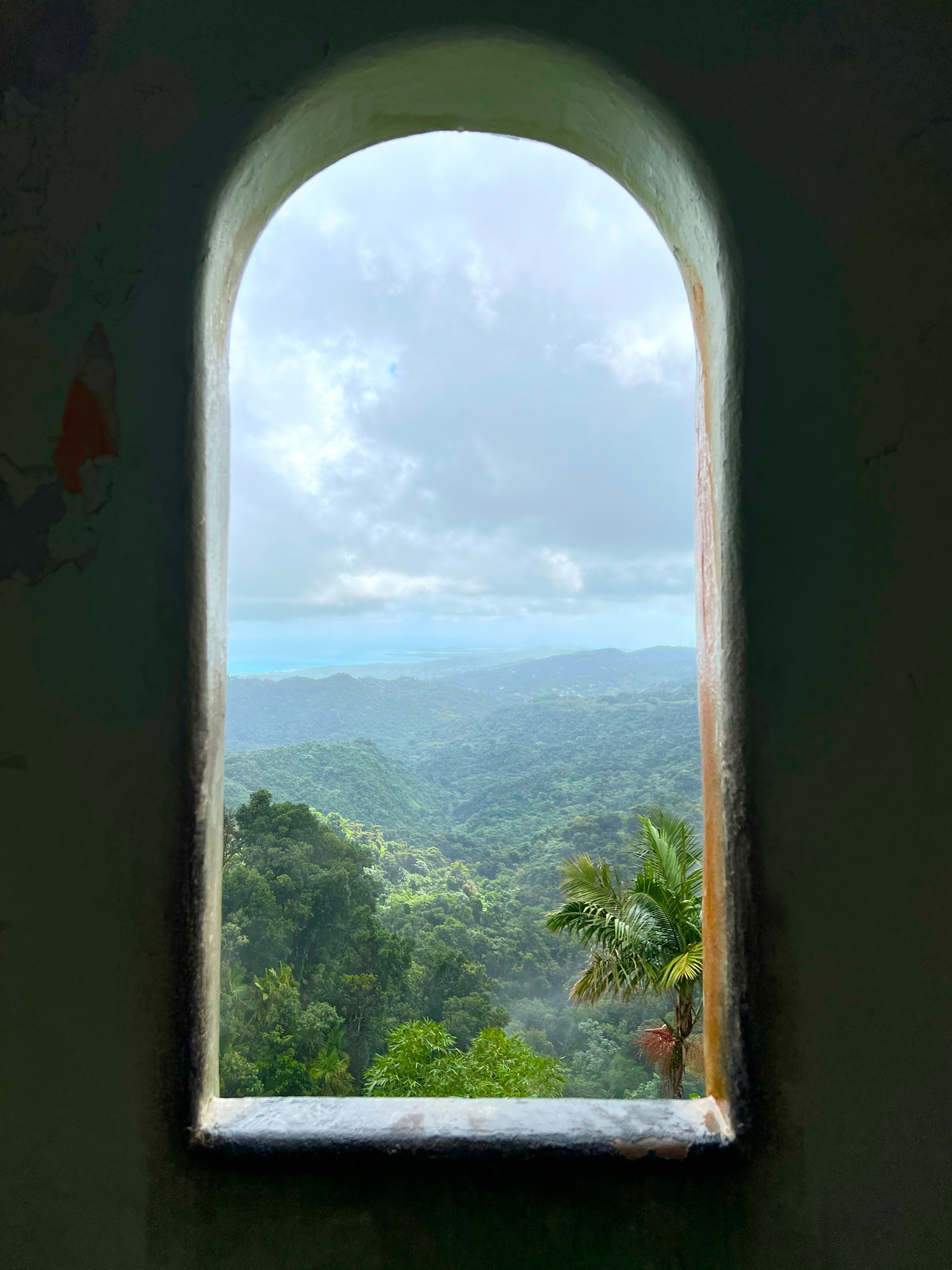
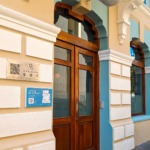
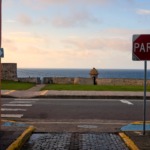
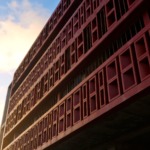
I recommend getting the latest copy of “Puerto Rico, Off the Beaten Path” and mapping out a route.
The book will tell you much more than a chamber of commerce will. Example of places that left a lasting impression on me:
Coamo Hot Springs,
El Túnel (railroad tunnel) at Guajataca where a minor fresh water stream drains into the Atlantic and you can usually surf / body surf.
The Dry Forest, where an abandoned Spanish Lighthouse stands, and there is a park where you can get in the water.
I found some cotton bolls there that I germinated, and they grew quite tall.
Drive to Cerro de Punta and look over La Isla from almost 4,400 feet in elevation.
Drive La Ruta Panorámica which traverses the Island from east to west—over 150 miles of roadway.
Stop at a small store in the mountains to get a taste of the local flavor that is missing from the tourist areas
Staying at a small motel in Utuado in the mountains and using it as a base for day trips.
Locally there, you can see a few places that memorialize the Independentistas who wanted freedom from the USA .
In what is known as the “Jayuya Uprising” the US Air Force bombed and strafed houses in Utuado and Jayuya.
Seems unbelievable, no?
It’s true.
Go to Club Gallistico in Carolina and watch the action of the bettors, if the sport is not offensive to you.
Free admission for mujeres.
I don’t care for crowds and crime, so I avoid Ponce, Mayaguez & San Juan.
Remember -Off The Beaten Path, and bring as much knowledge of Español as you can muster.